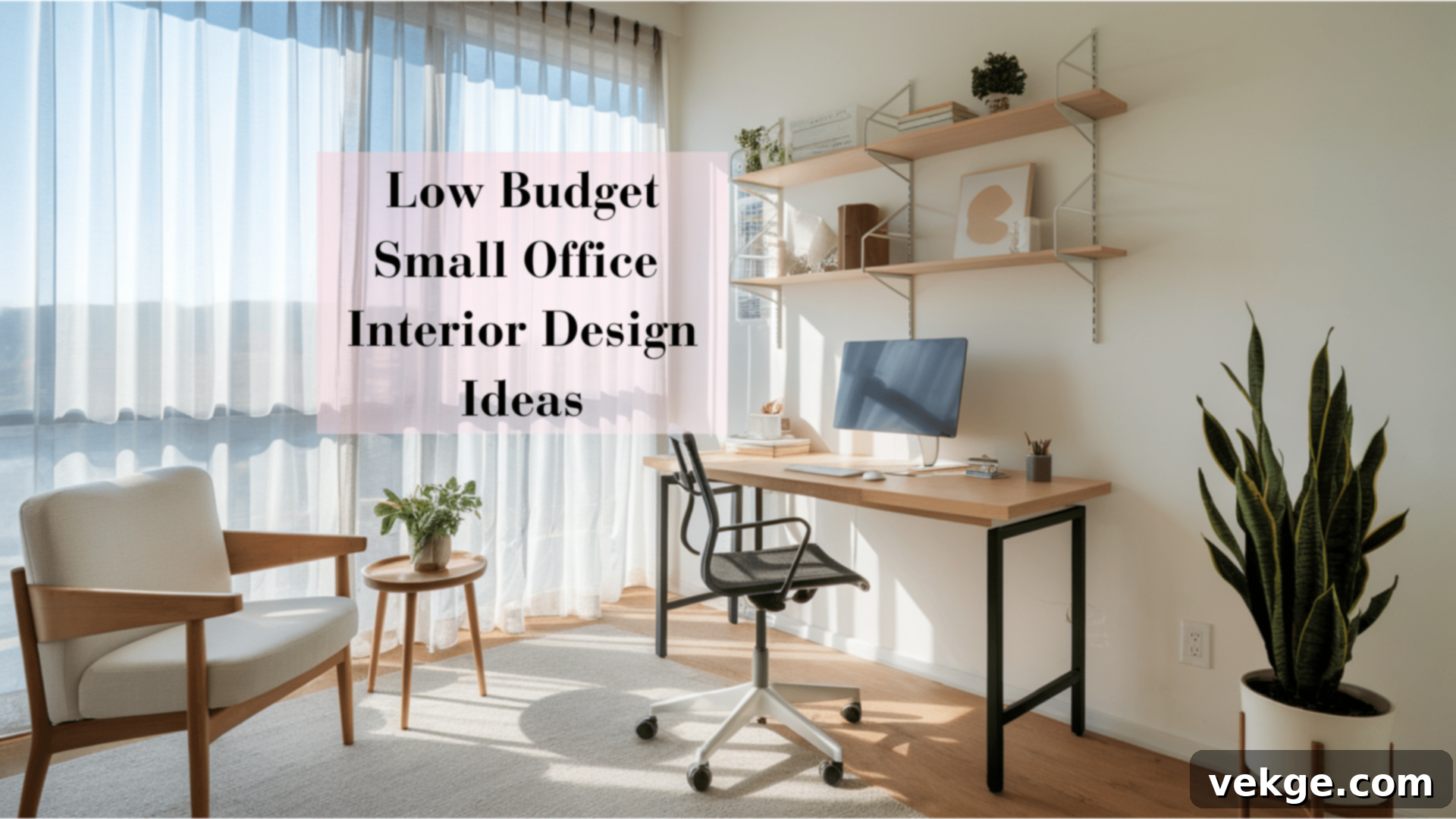Budget-Friendly Small Office Design Ideas: Create an Inspiring Workspace on a Shoestring
Setting up an efficient and aesthetically pleasing small office can seem daunting, especially when budget constraints are a major concern. Many business owners and remote workers face the challenge of creating a functional workspace without overspending. The good news is that with smart planning, creative thinking, and a focus on cost-effective solutions, you can design an office that is both highly functional and visually appealing.
This comprehensive guide will walk you through more than 30 innovative, budget-friendly ideas to help you maximize your space, select the right items for your needs, and cultivate an environment that fosters productivity and well-being. From clever storage hacks to smart furniture choices and personal decorative touches, your small office can become a place you genuinely enjoy working in, all while keeping your finances intact.
Smart & Budget-Friendly Interior Design Ideas for Your Small Office
Crafting a functional and stylish office space on a tight budget is not just possible; it’s an opportunity to unleash your creativity. You don’t need to spend a fortune to build an efficient and inspiring workspace. By strategically maximizing every inch of your space, opting for multi-functional furniture, and incorporating thoughtful personal elements, you can design a small office that perfectly blends practicality with visual appeal.
Whether you’re establishing a dedicated home office or furnishing a compact business space, these actionable and budget-conscious ideas will empower you to make the most of your surroundings without ever having to compromise on quality or comfort. Let’s dive into transforming your small office into a powerful hub for success.
1. Maximize Vertical Storage
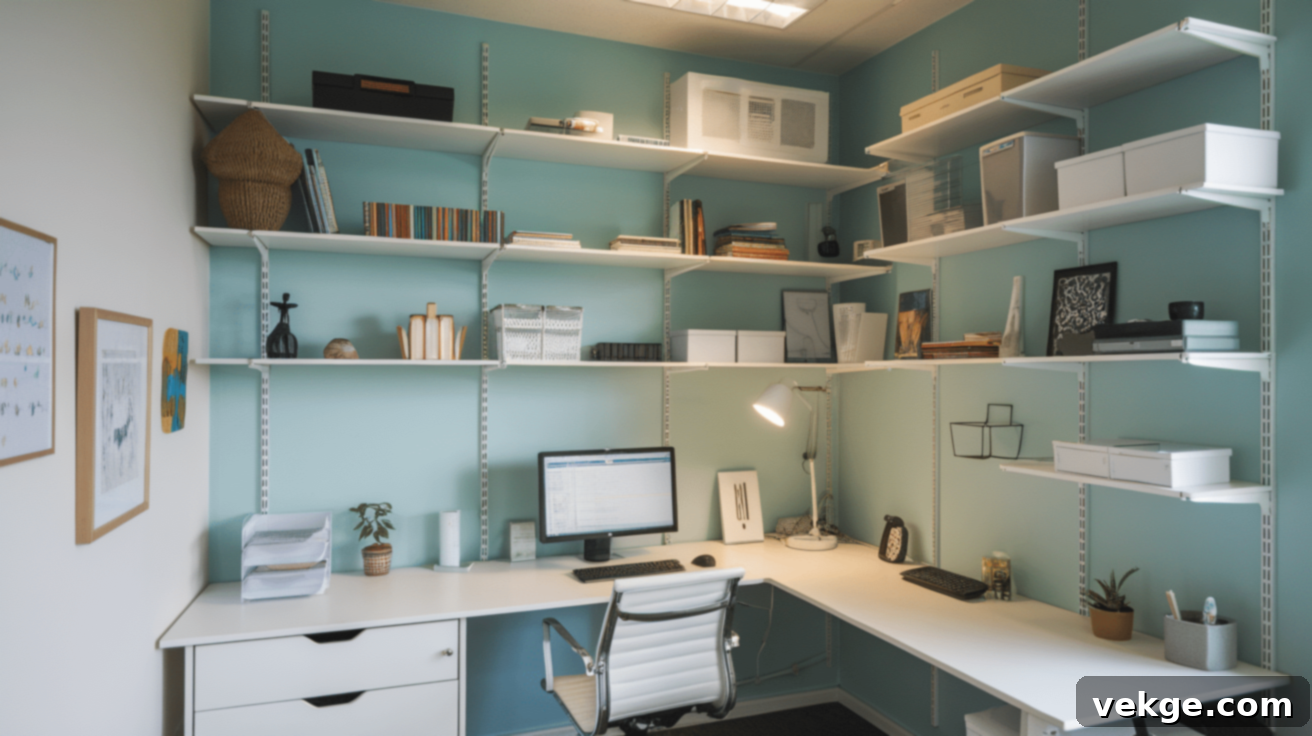
When floor space is at a premium, the only way to go is up! Vertical storage is a game-changer for small offices, allowing you to reclaim valuable square footage by utilizing wall space. Tall bookcases that extend close to the ceiling provide ample storage for books, files, and supplies without eating into your working area.
Consider wall-mounted storage units or floating shelves to keep items off your desk and floor, making the room feel more open and organized. These are perfect for displaying essential office basics, small decorative items, or even a few small plants. Don’t forget often-overlooked areas like the space above your desk, doors, or windows – these can be fitted with shelves for items you don’t need daily but still require organized storage. Small, inexpensive bins or baskets on these shelves can help categorize items, maintain a tidy appearance, and add a touch of style.
2. Choose Multi-Functional Furniture
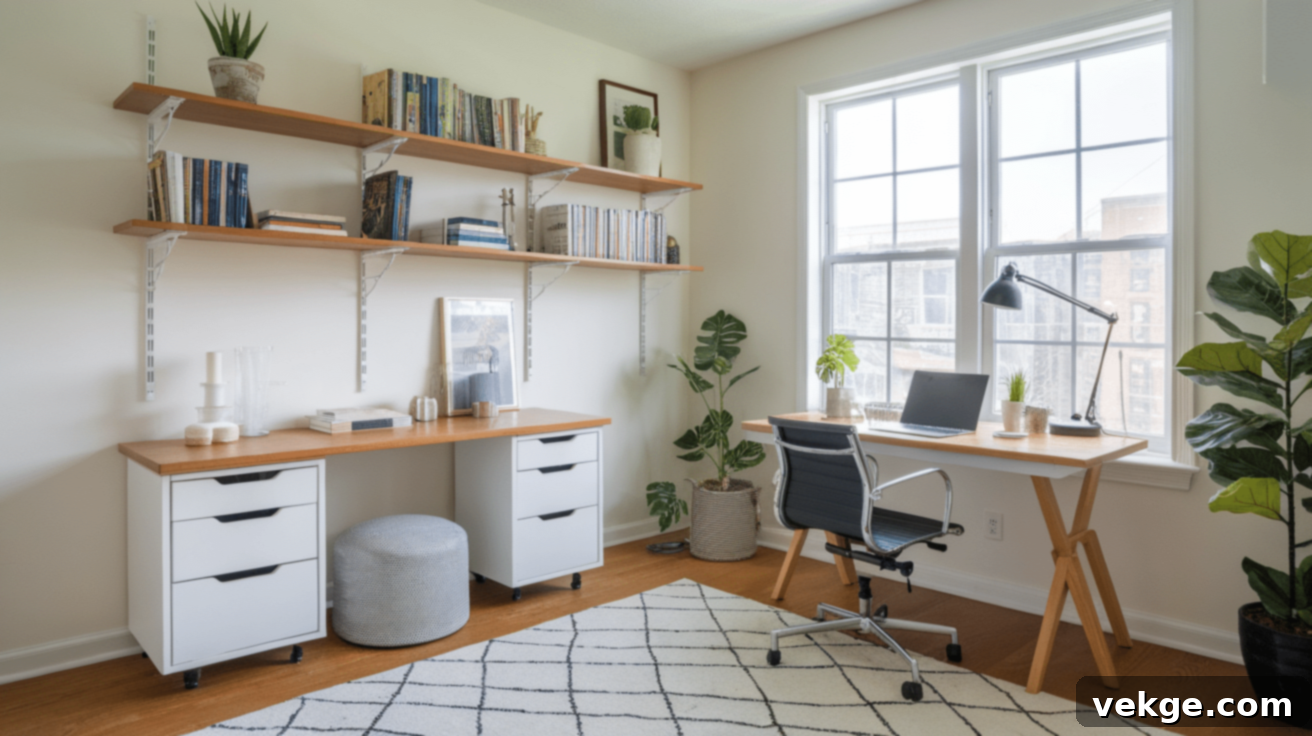
One of the smartest investments for a small office on a budget is furniture that serves multiple purposes. Each piece should earn its place by offering at least two functions. For instance, foldable desks and chairs can be easily stowed away when not in use, instantly opening up your floor area for other activities or making a small room feel much larger.
Storage ottomans are excellent additions, providing extra seating for guests or a footrest for yourself, all while offering concealed storage for office supplies, cables, or documents. Look for desks with integrated drawers, shelves, or compartments, eliminating the need to purchase separate storage units. Modular furniture pieces, such as stackable containers or adjustable shelving systems, offer incredible flexibility, allowing you to reconfigure your setup as your needs change without having to buy new items. This approach not only saves money but also significantly optimizes your limited space.
3. Go for Open Plan Layouts (or the Illusion of One)

Even if you can’t physically remove walls, you can create the illusion of an open plan layout in a small office. The goal is to maximize visual flow and natural light, making the space feel less confined and more welcoming. Start by ruthlessly decluttering; keep only essential items that serve a clear purpose in your workspace. Remove anything that hasn’t been used in months or contributes to visual clutter.
Arrange your furniture strategically, often pushing larger pieces against the walls to leave the center of the room as open as possible. This creates clear pathways, reduces crowding, and makes it easier to move around and adjust your setup, even in very limited square footage. A clean, simple layout not only improves the aesthetics but also enhances productivity by reducing distractions and promoting a sense of calm.
4. Use Neutral Wall Colors
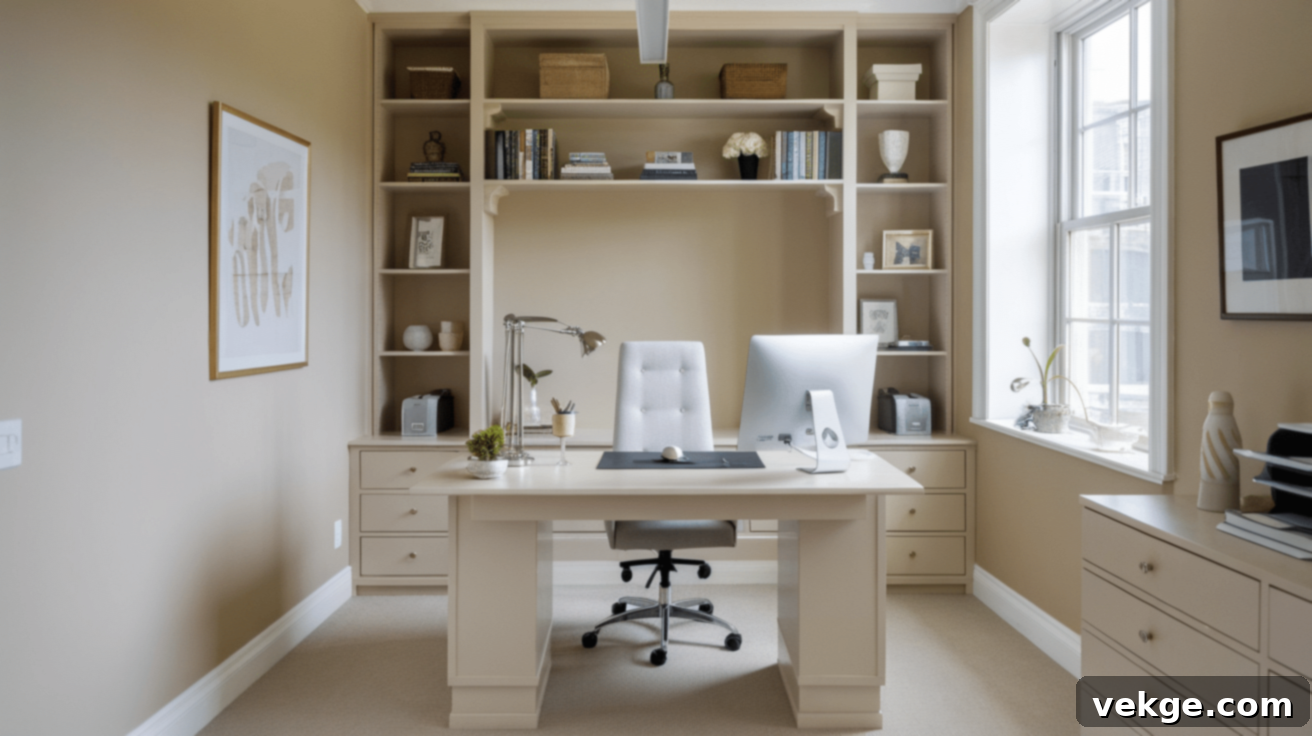
The power of light, neutral wall colors in a small office cannot be overstated. Shades like white, off-white, light beige, or pale gray are your best friends as they reflect natural and artificial light, making any room feel significantly larger, brighter, and more airy. This instantly creates a spacious feel without adding a single square foot or incurring significant costs beyond the paint itself.
Neutral backgrounds also offer incredible versatility. They provide a clean, timeless canvas that pairs well with almost any furniture style and color palette. This means you won’t feel the need to repaint when you decide to change your desk accessories or update other decor items, saving both time and money in the long run. For a touch of visual interest, introduce pops of color through easily changeable elements like desk accessories, picture frames, or a vibrant plant, rather than committing to bold wall colors.
5. Opt for a Corner Desk Setup
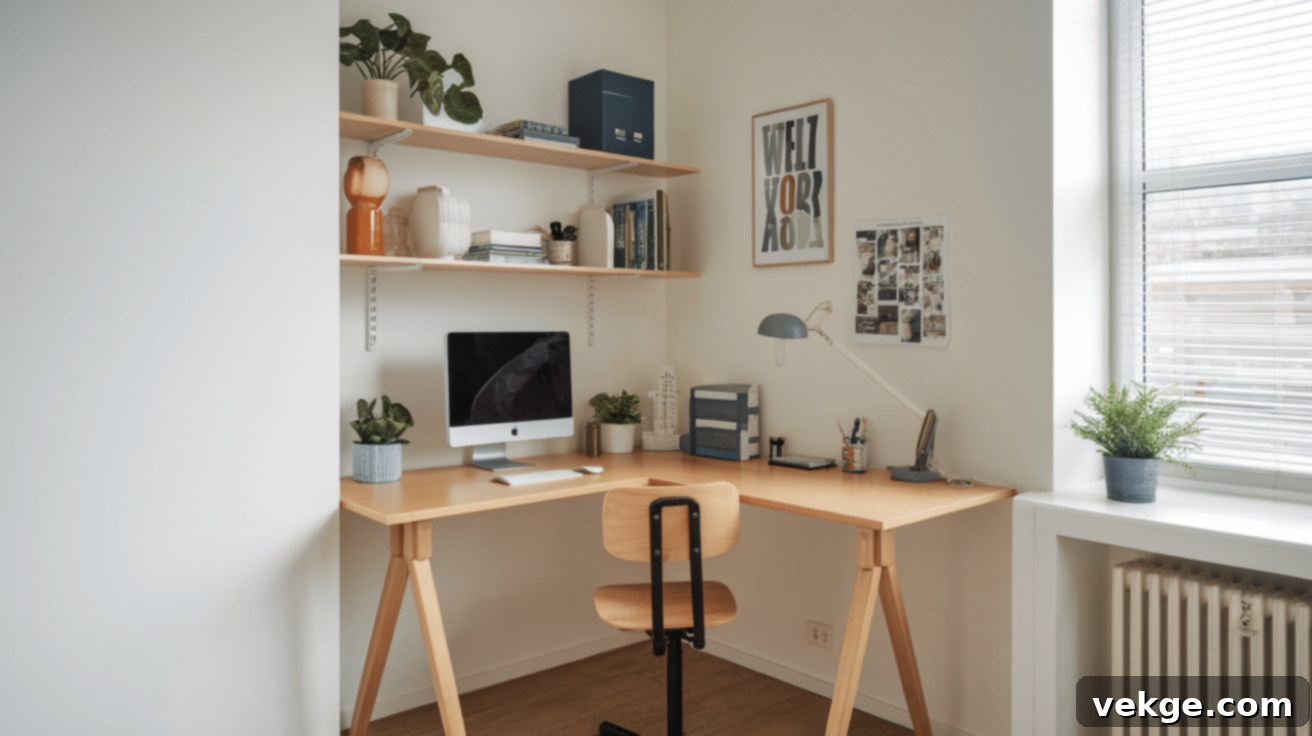
Corner spaces are often overlooked or underutilized, yet they hold immense potential for small offices. A desk specifically designed to fit into a corner is an incredibly efficient way to use space that might otherwise go to waste. L-shaped corner desks are particularly effective, providing an expansive work surface that keeps everything within easy reach. You can dedicate one side for your computer and the other for paperwork, a printer, or frequently used tools, all without feeling cramped.
Many corner desk models come with built-in shelves or storage compartments, giving you additional space for supplies without requiring extra furniture. This is a crucial advantage when every square foot matters. By embracing a corner setup, you create a dedicated and highly functional workstation that feels integrated into the room, rather than awkwardly placed, making the most of your office layout.
6. Utilize Wall-Mounted and Vertical Desks
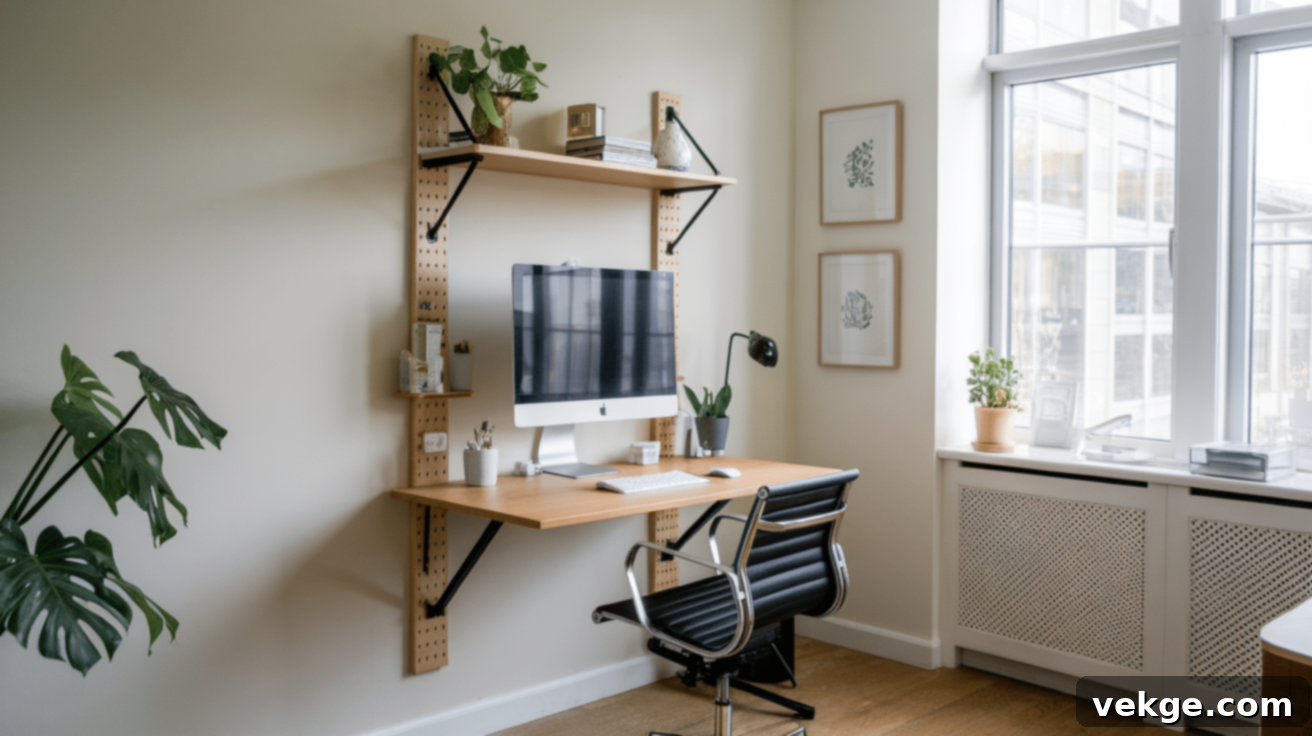
Wall-mounted desks attach directly to your wall, completely freeing up the floor space beneath them. This creates a visually open area that can be used for additional storage, a small filing cabinet, or simply more legroom. These desks can range from a simple, sturdy shelf with brackets to more sophisticated fold-down models that can be neatly tucked away when not in use, making them perfect for multi-purpose rooms.
Adjustable height desks, often referred to as standing desks, are another excellent “vertical” solution. They allow you to switch effortlessly between sitting and standing positions throughout the day, which is beneficial for your health and keeps you more alert. While dedicated standing desks can be an investment, DIY options (as covered later) offer a budget-friendly way to achieve this flexibility. These space-saving options are ideal for tiny offices where traditional, bulky desks would simply overwhelm the room, helping you create a complete and ergonomic workstation with a very small footprint, especially when paired with complementary wall storage above.
7. Incorporate Wall Art and Decor
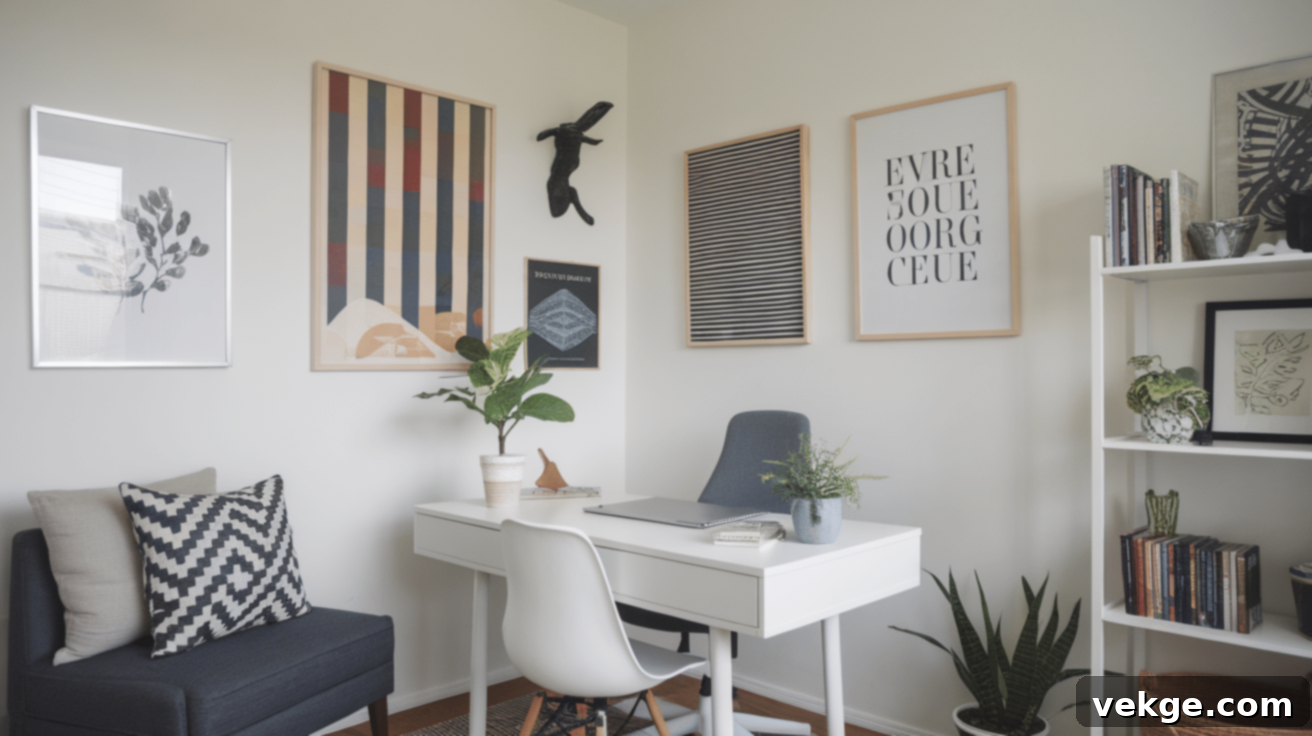
Wall art doesn’t need to be expensive to make a significant impact on your office’s atmosphere. Affordable prints from online shops, local artists, or even free printable art can introduce color, texture, and personality to your walls without straining your budget. Personal photos in simple, coordinating frames create a welcoming and familiar feel, making the space truly your own and fostering a sense of comfort and motivation.
For added visual interest, consider grouping several smaller frames together to create a gallery effect. DIY artwork offers an even more budget-friendly and personal touch – try making simple abstract designs, framing attractive fabric samples, or mounting postcards, calendar pages, or even pages from old books that feature inspiring imagery or quotes. Thoughtfully framed, these items can become eye-catching decor that reflects your style and keeps your office inspiring.
8. Add a Gallery Wall
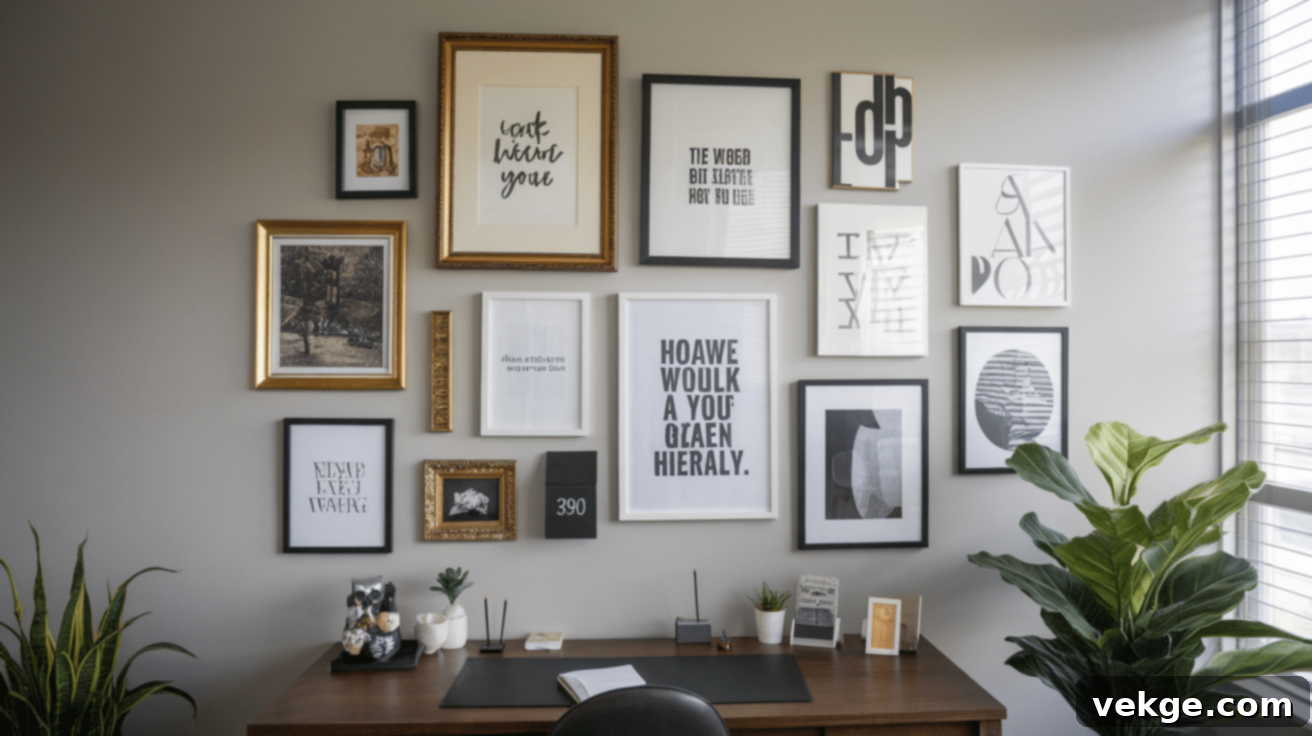
A well-curated gallery wall is a fantastic way to inject life and personality into a small office, and it can be achieved with minimal expenditure. You can find an assortment of unique frames at thrift stores, garage sales, or even online marketplaces for very little cost, or simply reuse old frames you already own. Don’t be afraid to mix different frame sizes, colors, and styles for an eclectic and interesting look that feels collected over time.
To create a gallery wall that truly reflects your office’s personality, include a mix of elements: motivational quotes, small pieces of artwork (which can be printed at home or sourced cheaply), meaningful photos, or even company values. This simple addition transforms plain walls into a dynamic and well-designed focal point without a big price tag. Before hanging, arrange your frames on the floor or use paper templates on the wall to finalize the layout. This planning ensures you get the arrangement just right the first time, avoiding unnecessary holes.
9. Use Sheer Curtains for Natural Light
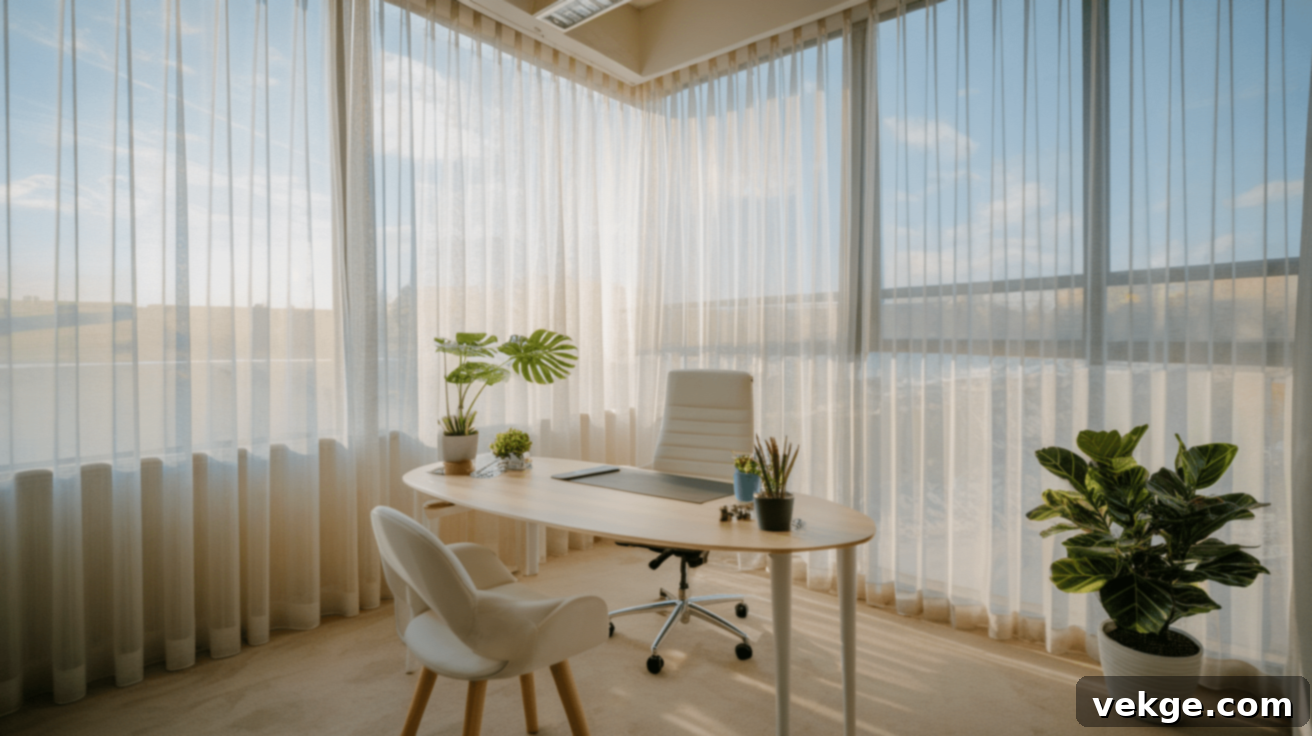
Sheer curtains are an intelligent choice for small offices that require a balance of natural light and privacy. These lightweight fabrics allow abundant sunshine to filter through, brightening the room and making it feel more expansive, while simultaneously offering a subtle barrier against prying eyes from outside. Natural light is not only beneficial for mood and productivity but also helps reduce your energy bills by lessening the need for artificial lighting during daylight hours.
To maximize brightness, opt for white, off-white, or very light-colored sheer curtains. Hang them high and wide to make the windows appear larger and draw the eye upwards, enhancing the feeling of space. These simple yet elegant window coverings are significantly more affordable than custom blinds, heavy drapes, or elaborate window treatments, making them an ideal, budget-friendly solution for small offices with tight budgets.
10. Go for Simple and Affordable Lighting
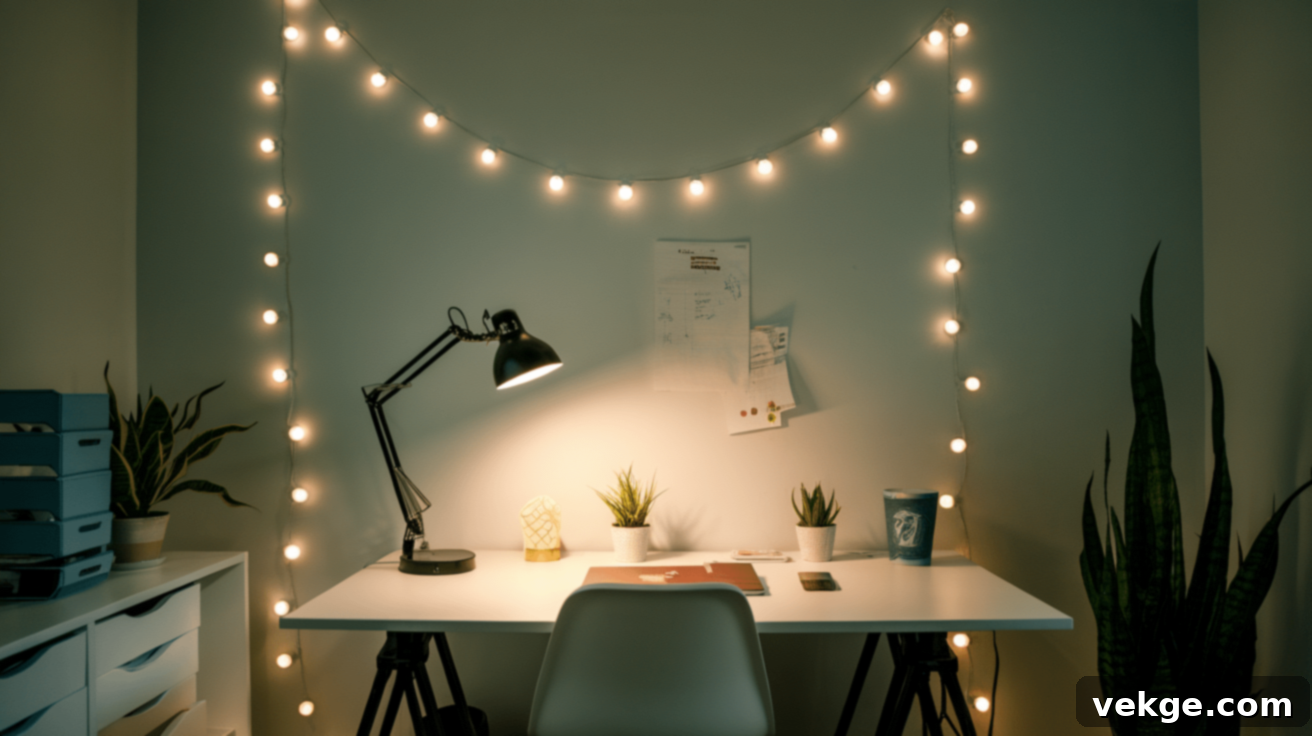
Effective lighting is crucial for productivity, but it doesn’t have to be expensive. Focus on layering light sources and choosing budget-friendly fixtures. LED desk lamps are an excellent choice for task lighting, providing focused illumination where you need it most while consuming very little electricity, which saves on energy bills. String lights can add a warm, inviting, and even whimsical ambient glow to your office at a minimal cost.
For general room lighting, basic floor lamps with a clean design can be found affordably and offer versatile light distribution. Strategically place your lighting at key work areas to maximize functionality and comfort without needing to brightly light the entire space. This targeted approach saves on both the cost of light fixtures and ongoing electricity expenses. Always keep an eye out for sales, or explore secondhand markets and online classifieds for quality lighting options at even better prices.
11. Incorporate Plants for Freshness
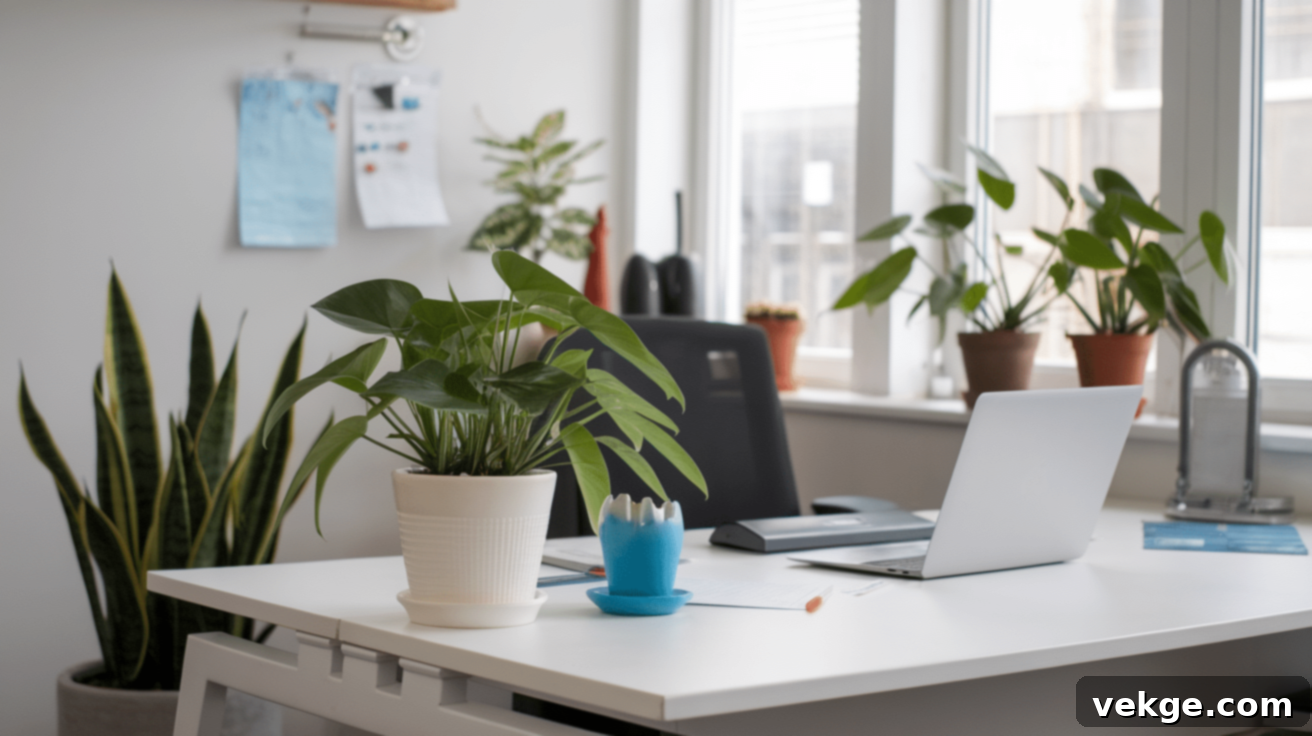
Bringing a touch of nature into your small office can make a remarkable difference to its atmosphere and your well-being. Small, low-maintenance plants like succulents, snake plants, pothos, or ZZ plants are perfect choices as they add life and color without taking up much space. These resilient plants require minimal care and can thrive even in offices with limited natural light, making them ideal for busy professionals.
Beyond their aesthetic appeal, plants offer numerous benefits: they help purify the air, reduce stress, and can even boost mood and concentration during the workday, creating a more pleasant and productive setting. To keep costs down, look for small pots at dollar stores, discount retailers, or repurpose containers you already have at home. Even just two or three carefully placed plants can significantly enhance the feeling of freshness and vitality in your office.
12. Consider a DIY Standing Desk
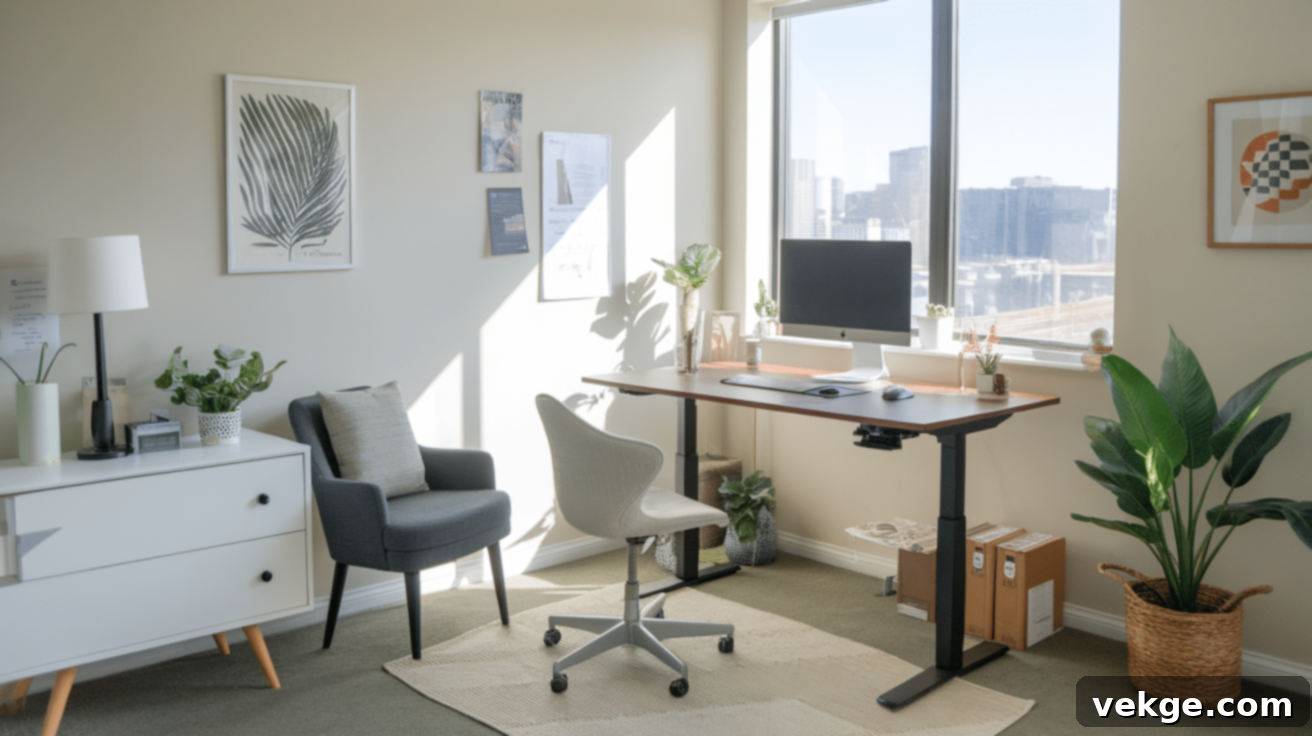
Investing in a standing desk is a fantastic way to improve ergonomics and combat the sedentary nature of office work, but a brand-new adjustable desk can be quite costly. Fortunately, a standing desk doesn’t have to break the bank. You can easily create a simple, budget-friendly standing option by stacking sturdy boxes, crates, or even strong books on your existing desk to elevate your monitor and keyboard to the correct height.
Wall-mounted shelves, installed at the right height, can also serve as effective standing workspaces. Adjustable laptop stands offer a portable and affordable way to switch between sitting and standing throughout the day, providing flexibility without a full desk overhaul. For a more polished DIY look, consider placing your regular desk on bed risers, or explore popular “IKEA hacks” that combine basic, inexpensive furniture pieces to create a functional standing desk at a fraction of the retail cost. This variety in your posture can help reduce back pain and keep you more alert and energized.
13. Repurpose Old Furniture
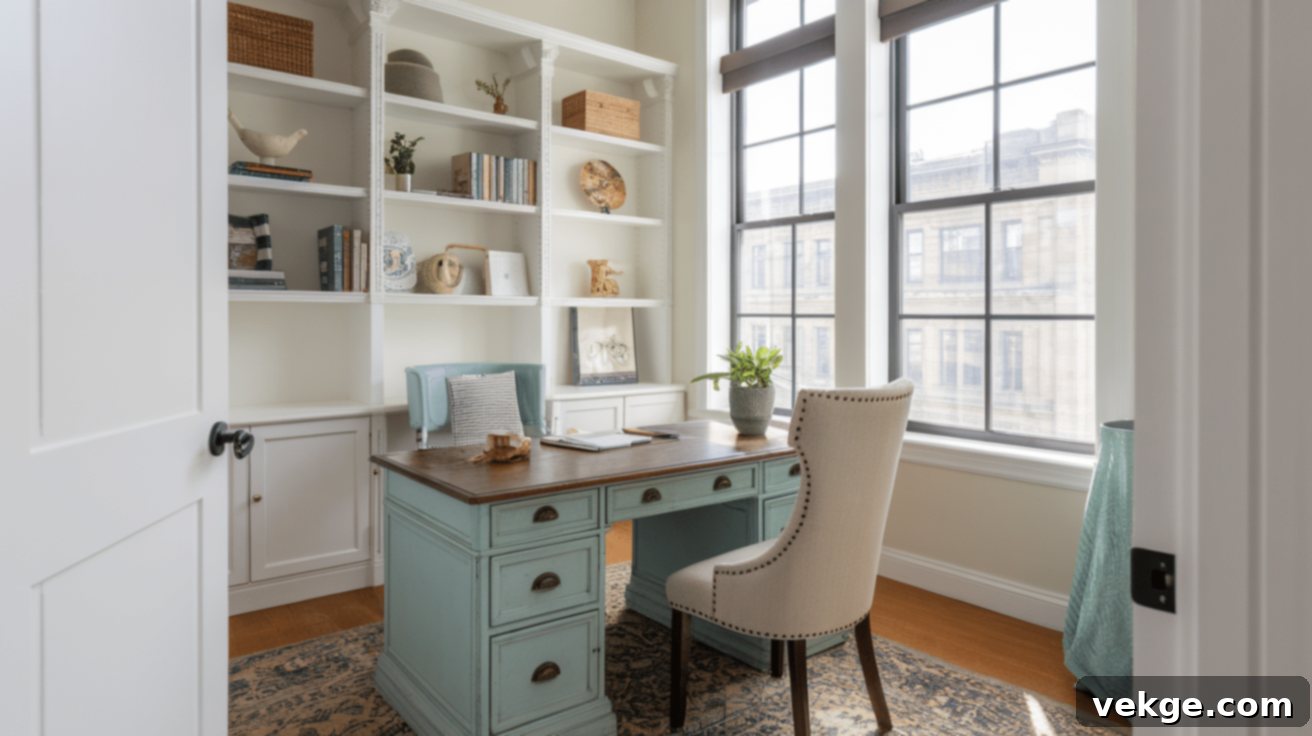
Giving old office furniture a new lease on life is a prime example of budget-friendly design that also adds unique character. A coat of paint or some fresh fabric can work wonders. A dated wooden desk can be completely transformed into a modern centerpiece with a fresh application of white, black, or even a bold accent color. Old chairs can be reupholstered with inexpensive fabric samples or a simple slipcover for an instant update.
Scour thrift stores, online marketplaces like Craigslist or Facebook Marketplace, and local garage sales for quality, solid pieces that just need minor updates. Often, solid wood furniture can be found at prices significantly lower than new particle board items. Small changes, such as replacing old handles or knobs on cabinets and drawers, can dramatically alter the look of storage pieces. These simple, creative updates allow you to achieve a custom, high-end office feel without the custom price tag, injecting personality and history into your workspace.
14. Create Custom Storage Solutions
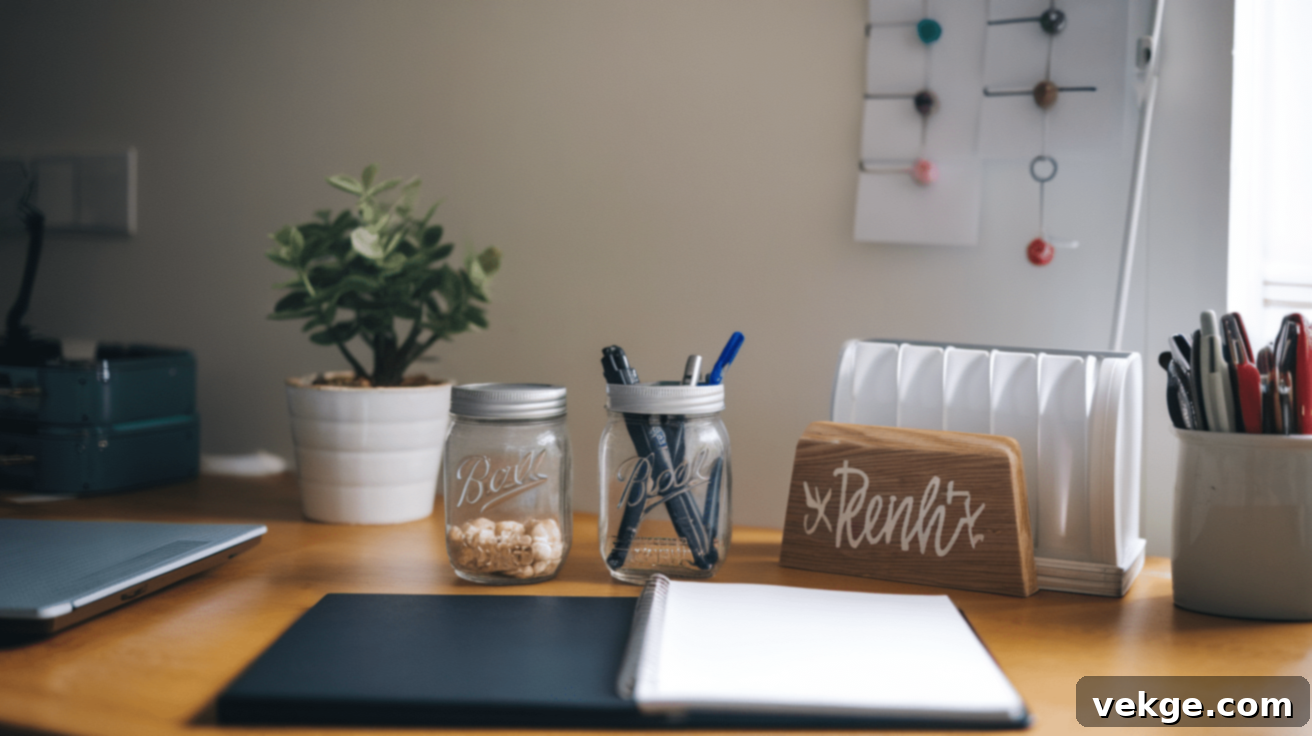
When off-the-shelf storage doesn’t fit your space or budget, get creative and make your own! Simple wooden crates or robust cardboard boxes can be stacked on walls (secured properly) or tucked neatly under desks to create versatile storage units. Painting them to match your office’s color scheme will give them a cohesive, put-together look, elevating them from mere boxes to intentional design elements.
Wall-mounted file folders or magazine racks keep important papers visible and accessible without consuming precious desk space. Under-desk hanging baskets can hold supplies like extra notebooks, snacks, or a small trash can, keeping your work surface clear and clutter-free. Magnetic strips installed on walls are excellent for organizing metal items such as scissors, staplers, or paper clips. Even simple mason jars or repurposed tin cans on shelves can stylishly hold pens, pencils, and other small office supplies. These DIY solutions ensure every inch of your office is used wisely, keeping costs low while maximizing organization.
15. Invest in a Comfortable, Budget-Friendly Chair
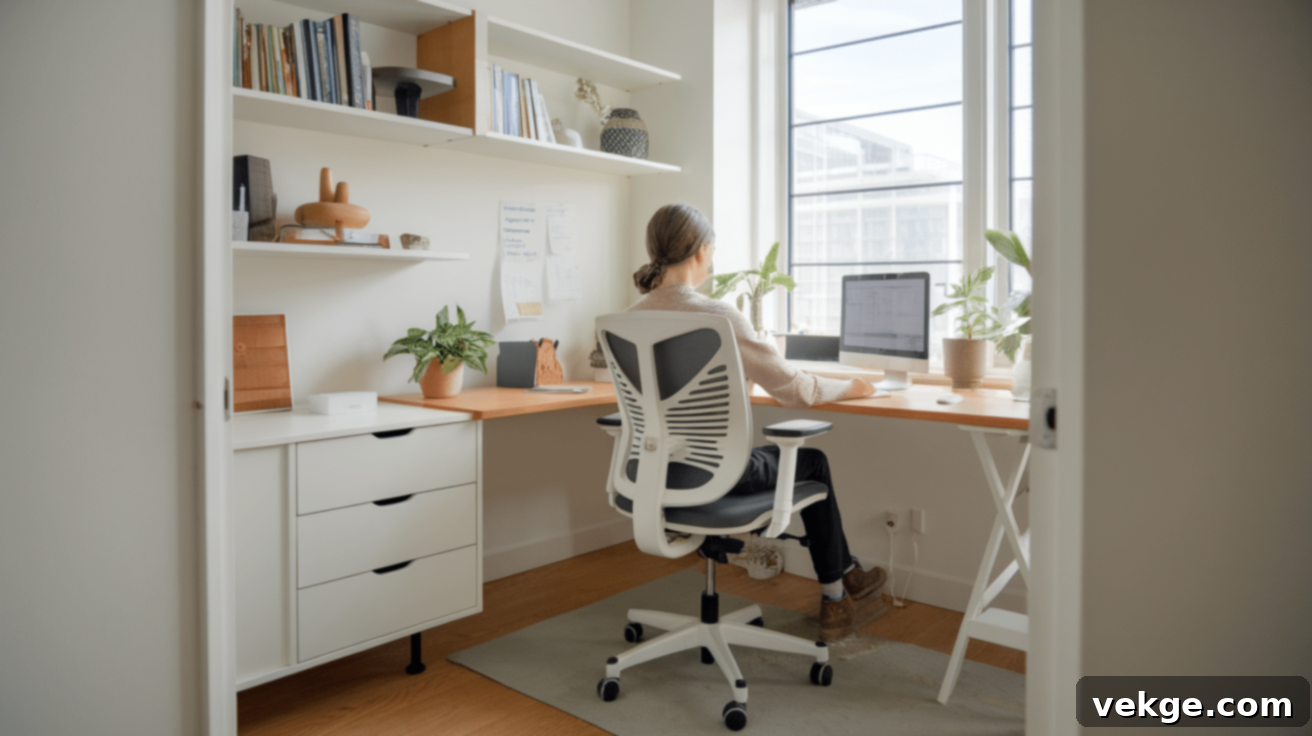
While the urge to save money on every item is strong, your office chair is one area where a little investment goes a long way for your health and productivity. Look for office chairs with decent ergonomic features, such as basic lumbar support and adjustable height, at discount stores, office supply sales, or large retailers. Many offer surprisingly good comfort without the hefty price tag of premium brands.
For even better deals, explore office furniture liquidation sales or auctions from companies that are closing down. These often sell high-quality, pre-owned chairs from reputable brands at steep discounts, providing excellent value. If buying a new chair isn’t immediately feasible, enhance your current chair with affordable additions like a separate lumbar support pillow and a comfortable seat cushion. These small improvements can dramatically increase comfort during long workdays, making a big difference for your body and focus.
16. Use a Compact Desk
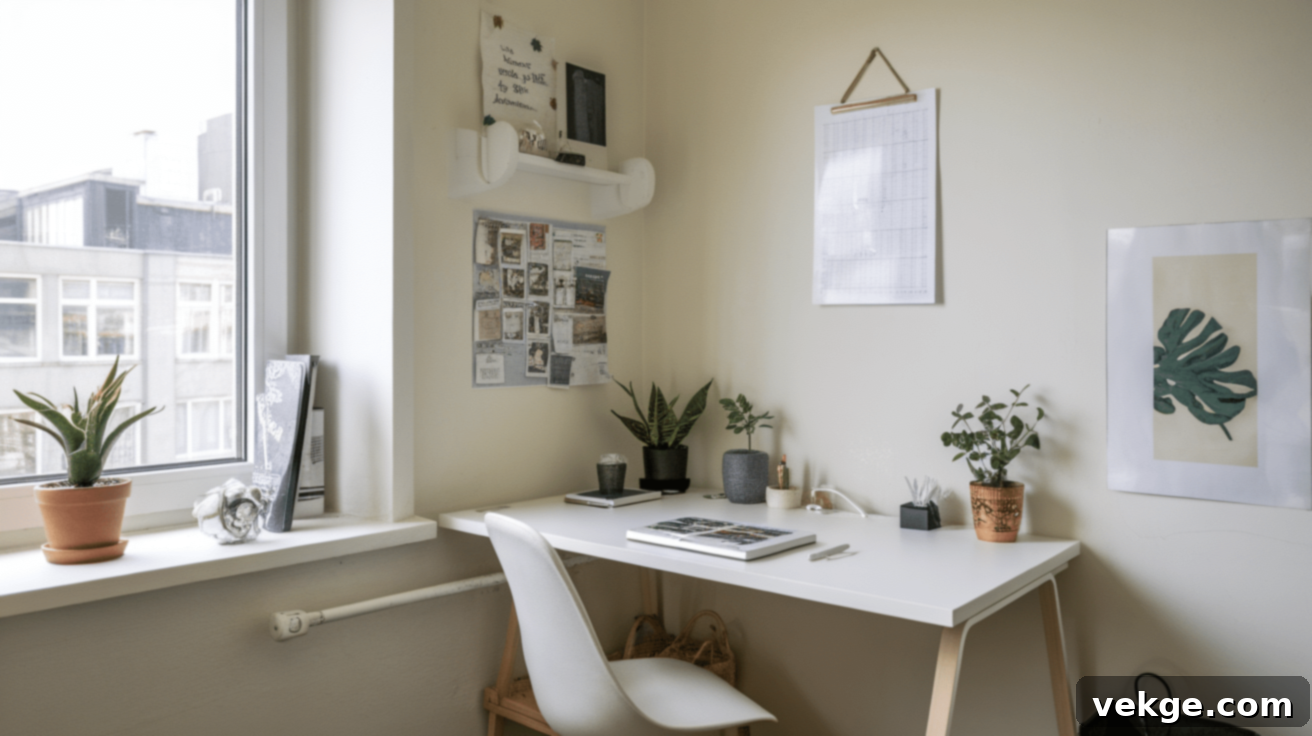
In a small office, every inch counts, and a compact desk is fundamental to maintaining an open, uncluttered feel. Opt for desks with clean lines, minimal bulk, and just enough surface area for your computer, a small notepad, and a few essential items. Overly large or ornate desks can quickly overwhelm a tiny room, making it feel cramped and busy.
Consider slim wall-mounted desks or floating shelves that serve as workstations, taking up virtually zero floor space. Folding desks are another excellent choice for very tight spaces or rooms that serve multiple functions, as they can be easily tucked away when not in use. Reflect on your actual needs; most people use far less desk space than they think. A simple, minimalist table with slender legs can often be more functional and aesthetically pleasing in a small office than a bulky traditional desk, and it almost always costs much less.
17. Go for Multifunctional Workstations
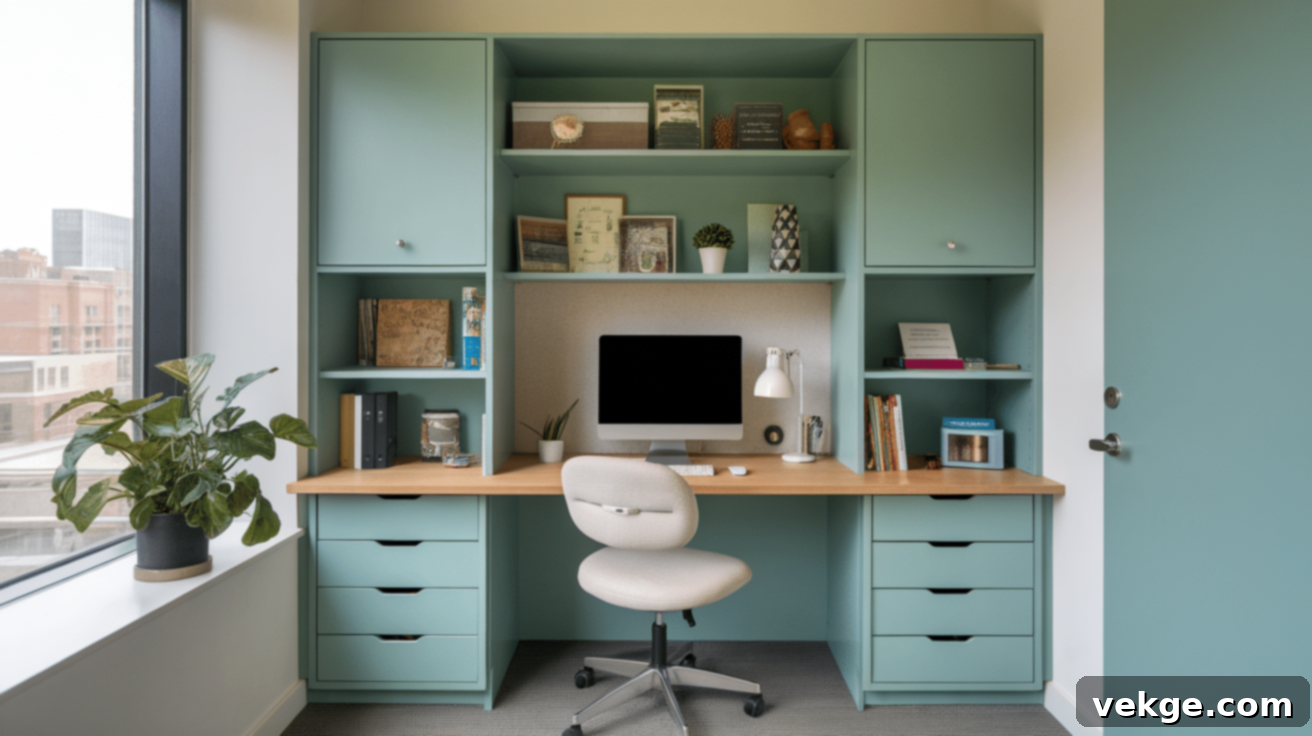
Beyond individual pieces of furniture, think about the workstation as a whole and how it can serve multiple functions. Look for desks that seamlessly integrate storage, such as those with built-in drawers, cubbies, or shelving, effectively combining work surface and organizational needs into one unit. Fold-down tables, often mounted to a wall, can act as full desks during the workday and then disappear to take up minimal space when not needed, perfect for dining-room-turned-office scenarios.
Adjustable coffee tables that can be raised to desk height are versatile for both casual client meetings and focused solo work, often featuring hidden storage compartments for office supplies. Similarly, wall-mounted drop-leaf desks can function as workstations when extended and transform into display shelves or decorative wall features when folded up. These dual-purpose items make your money and your space go further, ensuring your small office remains neat, organized, and highly functional throughout the day.
18. Install Floating Desks
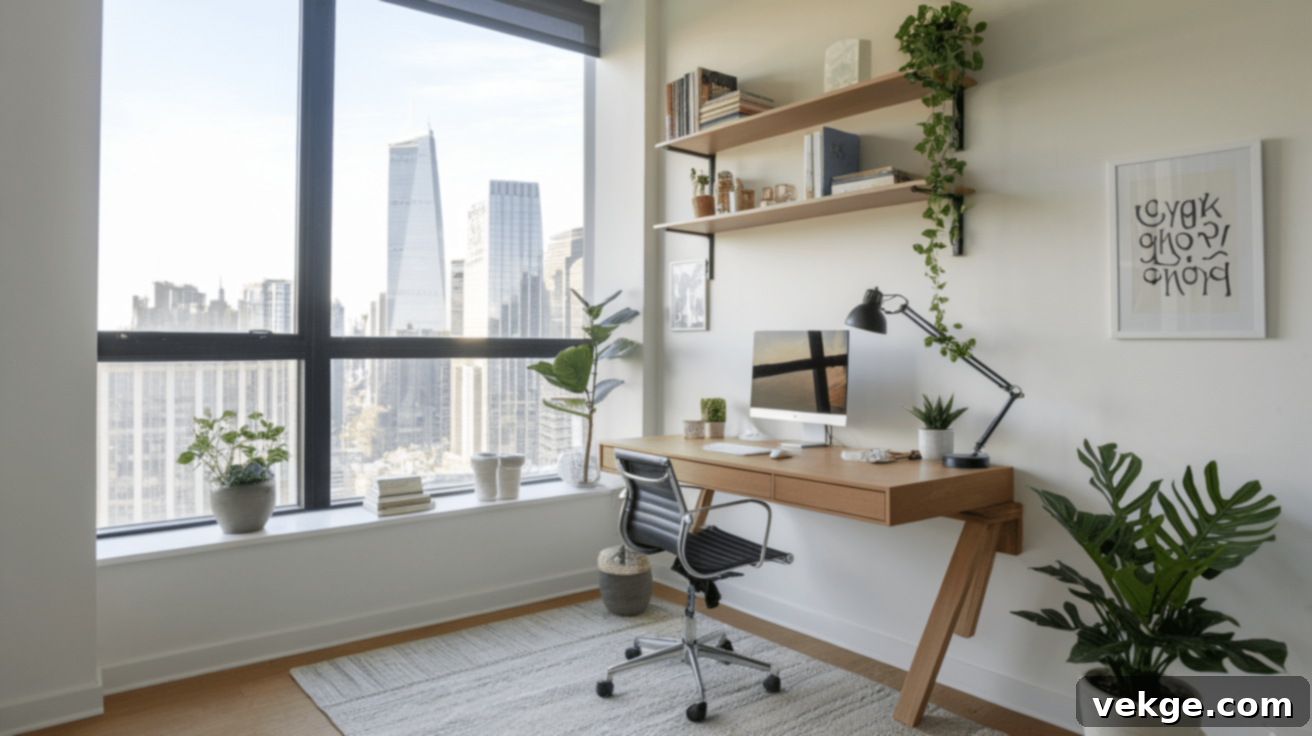
Floating desks, also known as wall-mounted desks, are a true revelation for maximizing space in small offices. By attaching directly to your wall, they eliminate the need for cumbersome legs, freeing up precious floor space and making even the tiniest rooms feel significantly larger and less cluttered. This minimalist approach is particularly effective in small apartments, dorm rooms, or dedicated home offices where every square inch matters.
Many designs offer the convenience of folding up when not in use, instantly providing extra room for other activities. You can find budget-friendly floating desk options in various sizes and styles, some even incorporating built-in storage. For the most affordable and customizable solution, consider a DIY approach: procure a sturdy wood board and heavy-duty brackets from a hardware store, then install it at your preferred height. This allows you to create a bespoke workstation that perfectly fits your space and needs.
19. Get Creative with DIY Desk Organizers
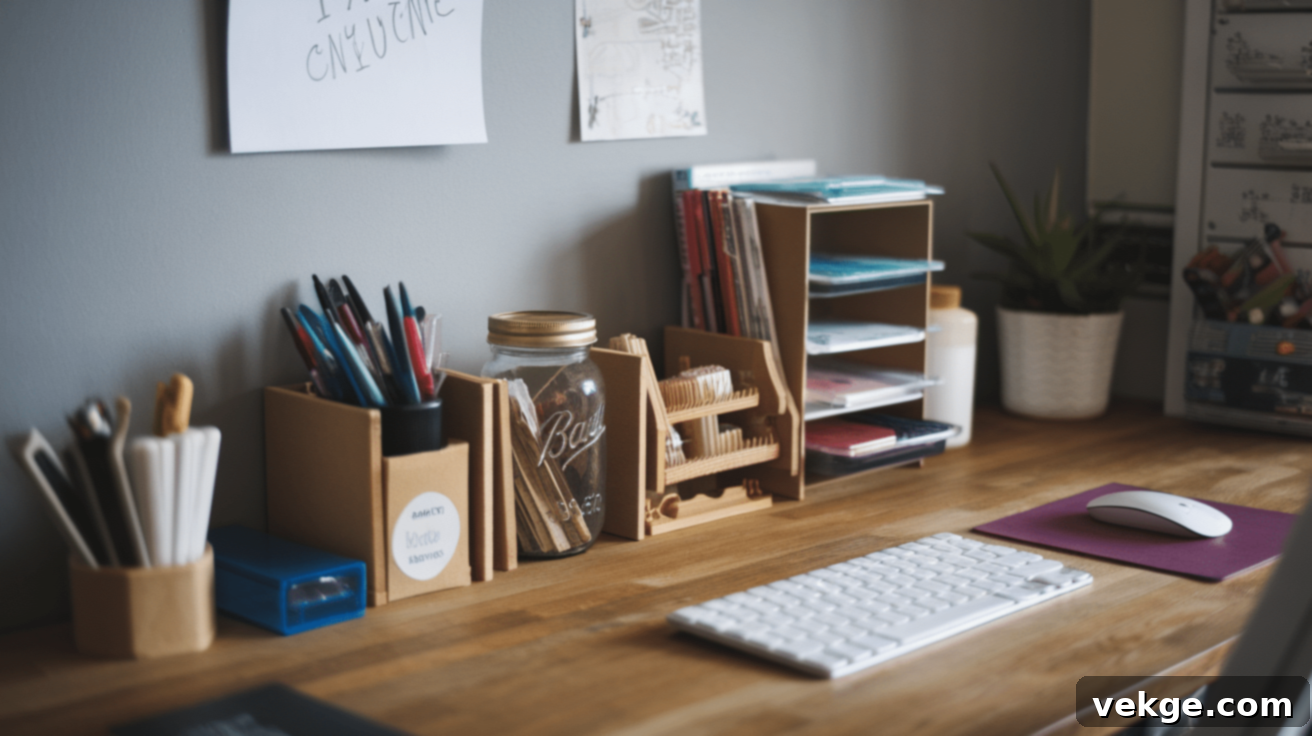
You don’t need to spend money on expensive store-bought desk organizers. Look around your home for items that can be repurposed into stylish and functional storage solutions. Mason jars, for instance, are perfect for holding pens, pencils, markers, and other tall supplies. Decorate old shoeboxes with wrapping paper, fabric, or paint to create custom-sized holders for papers, files, or electronics.
Cardboard tubes from paper towel or toilet paper rolls can be cut and arranged inside a box to neatly store and separate cords and cables, preventing tangled messes. Small tin cans, covered in attractive fabric or decorative paper, make chic and practical holders for office items like paper clips, thumbtacks, or rubber bands. These homemade solutions not only keep your supplies in order but also allow you to personalize your workspace to match your unique style and color scheme, all while keeping costs at an absolute minimum.
20. Repurpose Old Suitcases for Storage
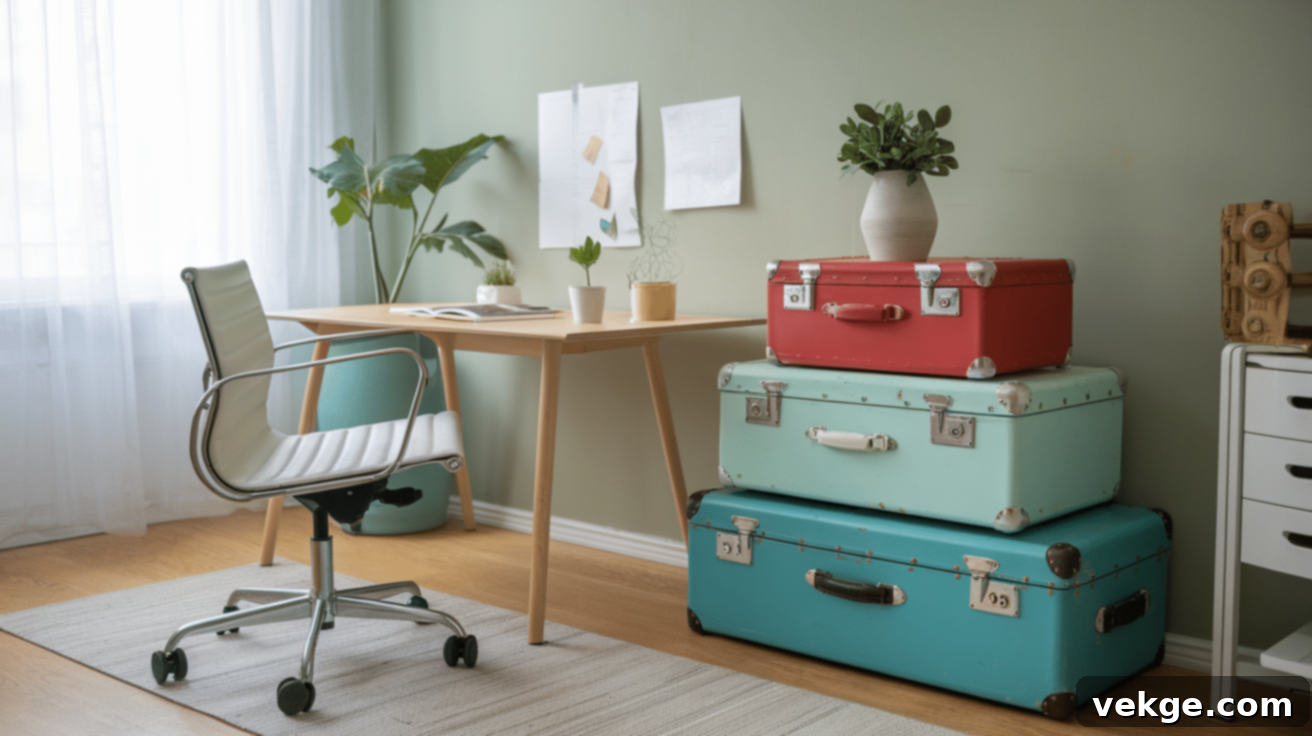
For a truly unique and budget-friendly storage solution, consider repurposing old suitcases. Vintage luggage offers charming hidden storage while adding a distinctive character and a touch of nostalgia to your small office. Clean up or paint old suitcases to store files, seasonal office supplies, or equipment that isn’t used daily, keeping clutter neatly out of sight.
Stack two or three different-sized cases to create an eye-catching side table next to your desk, providing both storage and a surface for a lamp or a plant. Alternatively, slide them under your workspace for easy access to items while maintaining a minimalist aesthetic. These ingenious storage solutions can cost almost nothing if you use suitcases you already own, or you can find them for a steal at thrift stores, antique shops, or flea markets. They infuse a personal, eclectic touch into your office while brilliantly solving storage challenges in confined spaces.
21. Choose Simple, Sleek Furniture
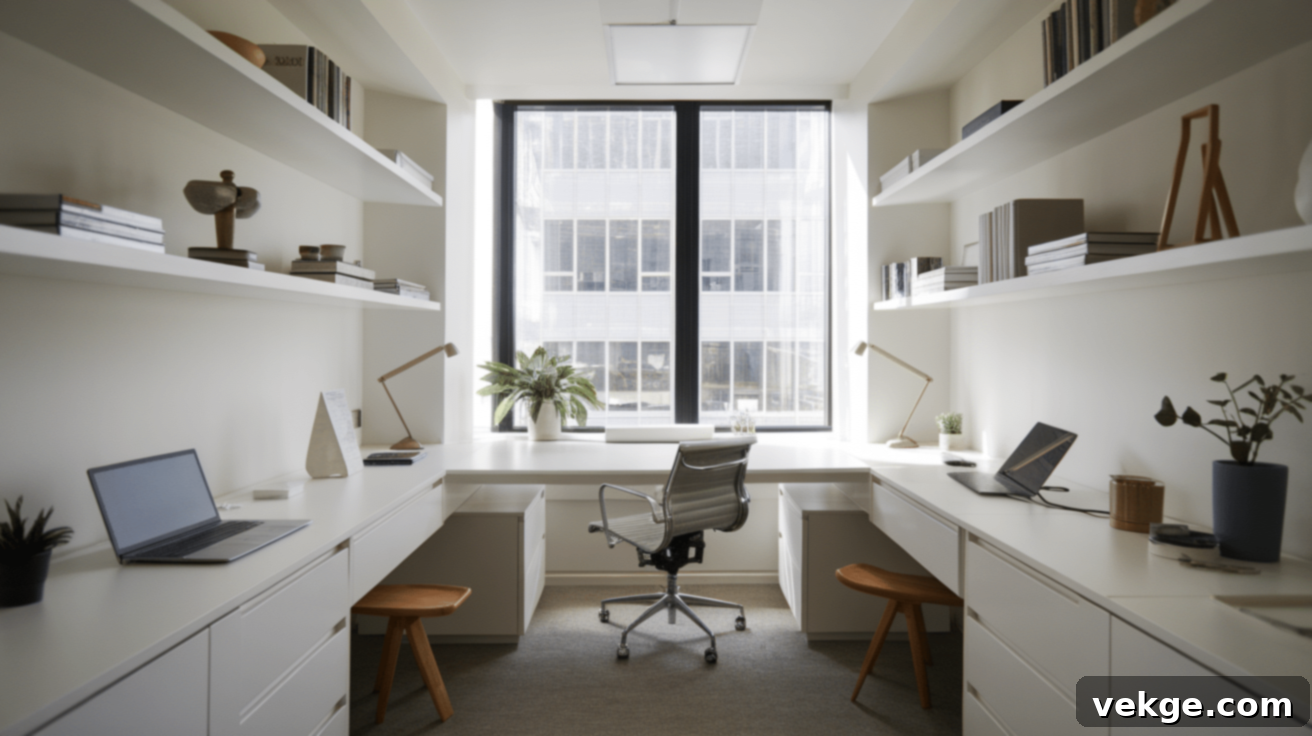
When decorating a small office, the adage “less is more” truly applies, especially to furniture. Opt for simple, sleek furniture designs with clean lines to ensure the space feels open, airy, and uncluttered. Desks with slim legs, minimalist profiles, and open bases allow light to flow through the room, making it appear larger than it is. Avoid bulky, heavy pieces that absorb light and visually crowd your limited area, creating a sense of claustrophobia.
Look for chairs without cumbersome arms and choose storage units with smooth, unadorned fronts rather than ornate details. When shopping on a tight budget, focus on basic shapes in neutral colors (white, black, natural wood tones) that won’t overwhelm the eye. The less visual clutter your furniture creates, the more spacious, calm, and inviting your office will feel, allowing you to focus better and work more comfortably, even when square footage is limited.
22. Build a DIY Bookshelf
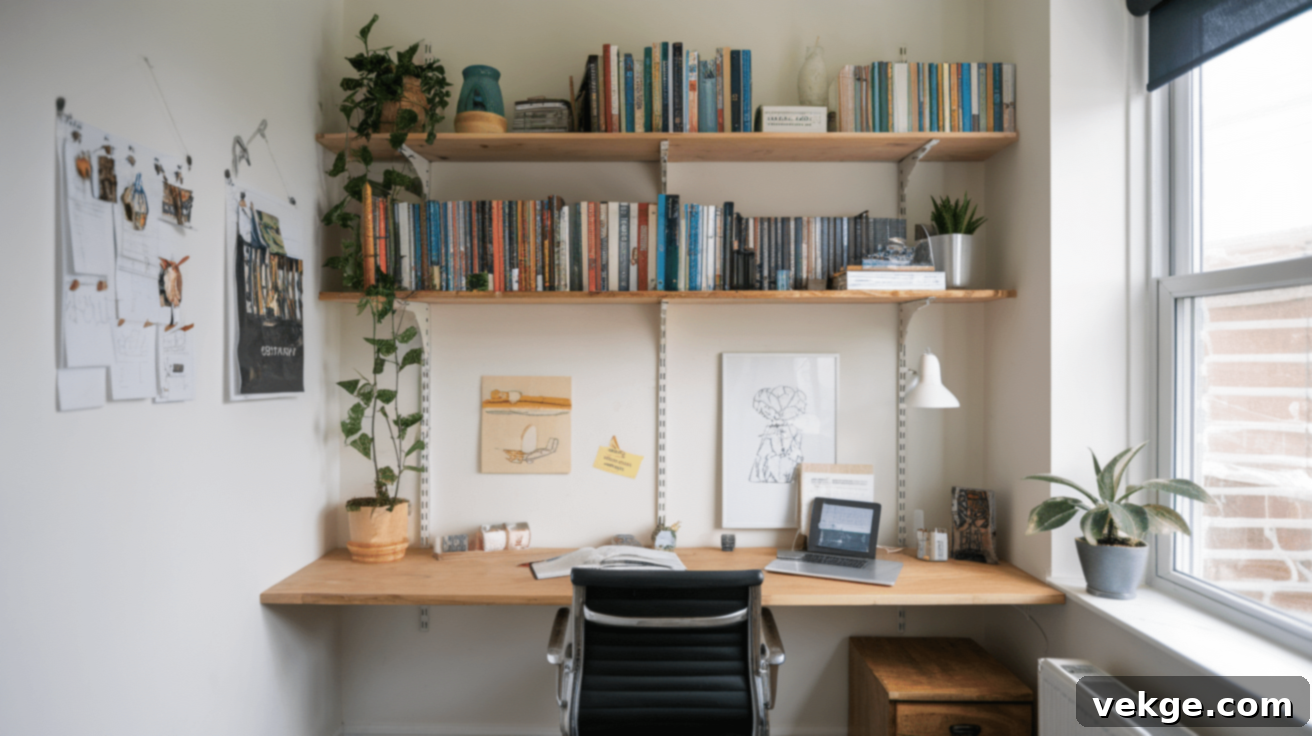
Store-bought bookshelves can be expensive and may not perfectly fit the unique dimensions of your small office. A highly budget-friendly and customizable alternative is to build your own. You can create a custom bookshelf using basic wood boards and sturdy L-brackets purchased from any local home improvement store. Begin by accurately measuring your available wall space to design shelves that fit perfectly, utilizing every inch without awkward gaps.
For the simplest design, mount the L-brackets securely to wall studs and place pre-cut wood planks on top. You can then paint or stain the wood to complement your existing office style, giving it a professional, finished look. These homemade shelves provide ample storage for books, binders, files, and office supplies, while also offering a stage for a few personal items or decorative accents. The total cost remains significantly lower than comparable retail options, and you gain the satisfaction of a truly custom, space-optimizing storage solution.
23. Maximize Space with Foldable Furniture
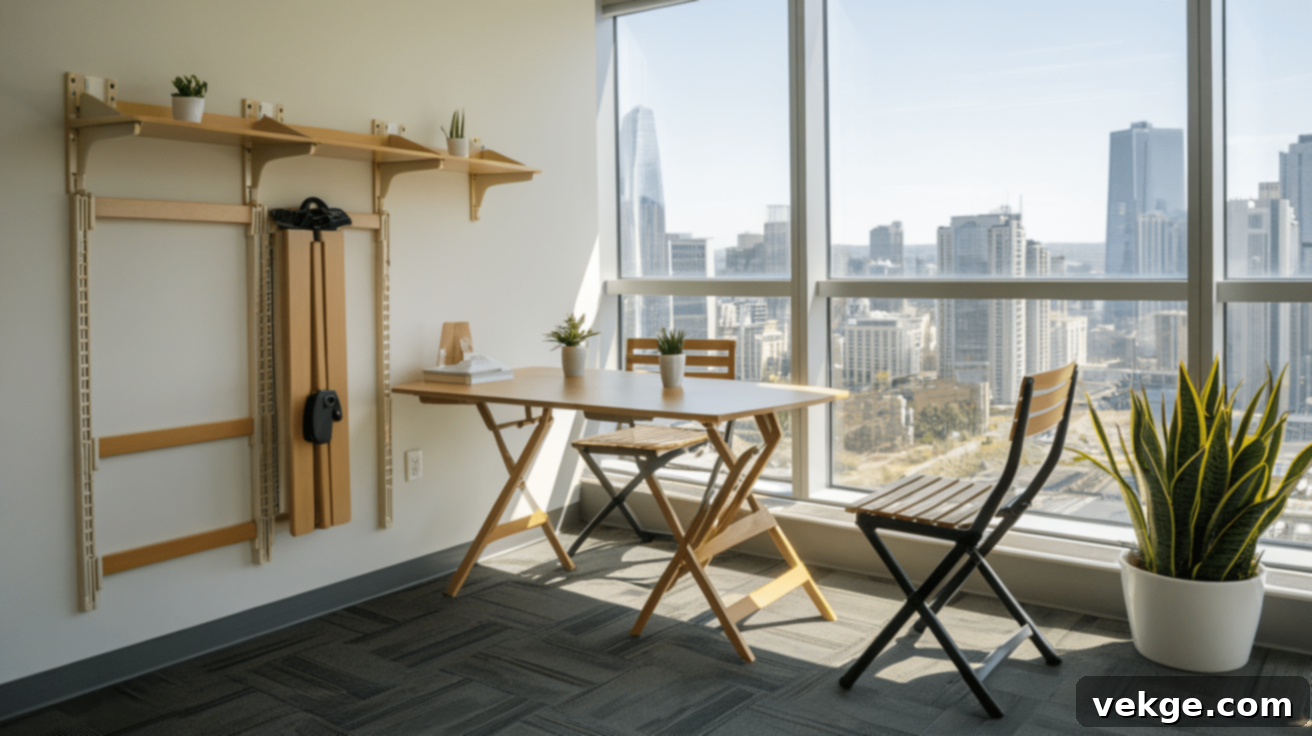
Foldable furniture is an indispensable asset for any small office, providing the flexibility to adapt your space to various needs throughout the day. Wall-mounted tables that fold down when required and discreetly tuck away when not in use are perfect for creating temporary workspaces in tiny rooms or multi-functional areas. Similarly, folding chairs can be easily retrieved when clients or coworkers visit, and then stored in a closet or hung on wall hooks afterward, keeping walkways clear.
Look for desks with drop-down sides that allow you to expand your work surface only when extra space is truly needed, and then compact it again. These items are key to ensuring your office can serve multiple functions – from a focused workstation to a meeting area or even an exercise zone – without constant clutter. The inherent space-saving nature of foldable pieces means your small office can dynamically adapt to different tasks and scenarios while remaining tidy, organized, and feeling significantly more open. Many budget-friendly stores and online retailers offer a wide selection of these versatile items at wallet-friendly prices.
24. Use Under-Desk Storage
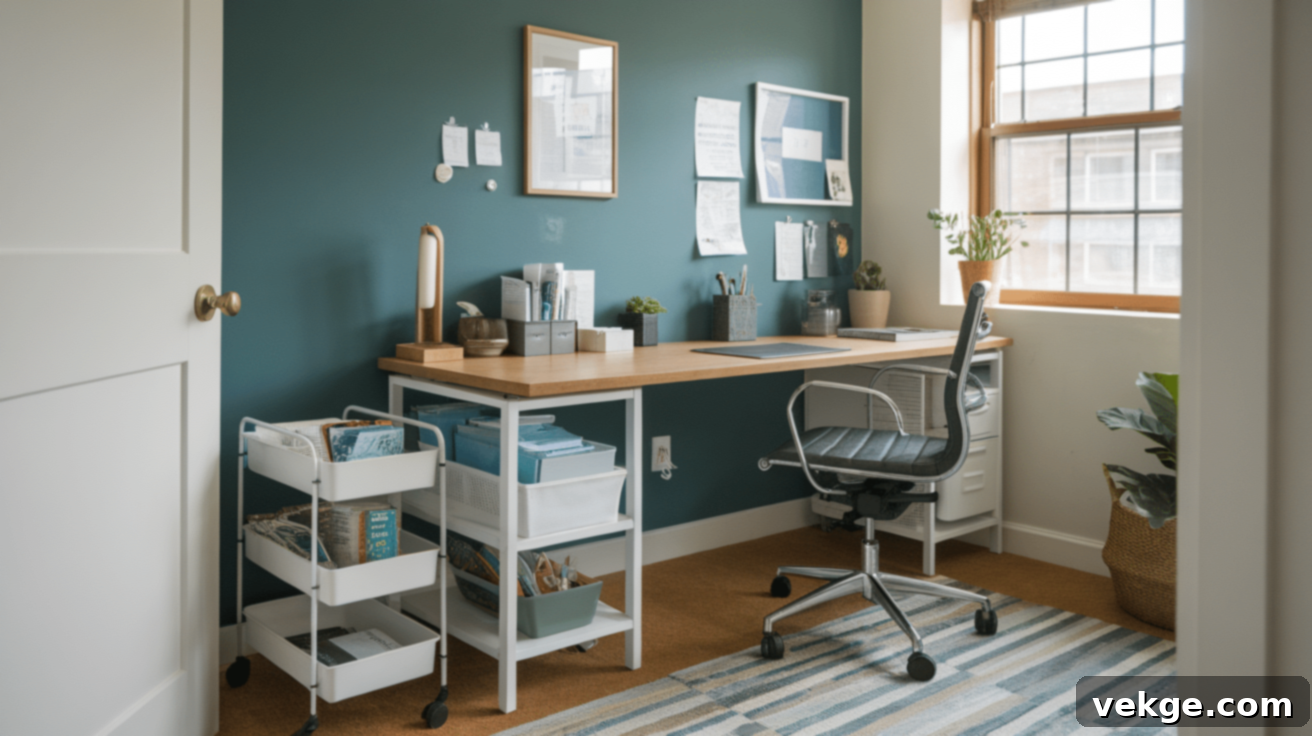
Don’t let the valuable space beneath your desk go to waste. This often-overlooked area is prime real estate for hidden storage that can significantly declutter your main work surface. Utilize rolling carts, small filing cabinets, or compact drawer units that fit snugly beneath your desk. These provide accessible storage for office supplies, files, stationery, and even personal items, keeping them close at hand but out of sight.
When selecting items, look for slim units that don’t impede legroom when you’re sitting comfortably. Filing cabinets on wheels are particularly versatile, allowing you to pull them out for easy access to documents and then tuck them away when not needed. For an ultra-budget-friendly option, use plastic storage bins with lids that slide effortlessly under your desk. This intelligent use of vertical and horizontal space ensures your desktop remains clear for productive work, making even the smallest office feel more open, orderly, and efficient.
25. Keep Desk Accessories Minimal
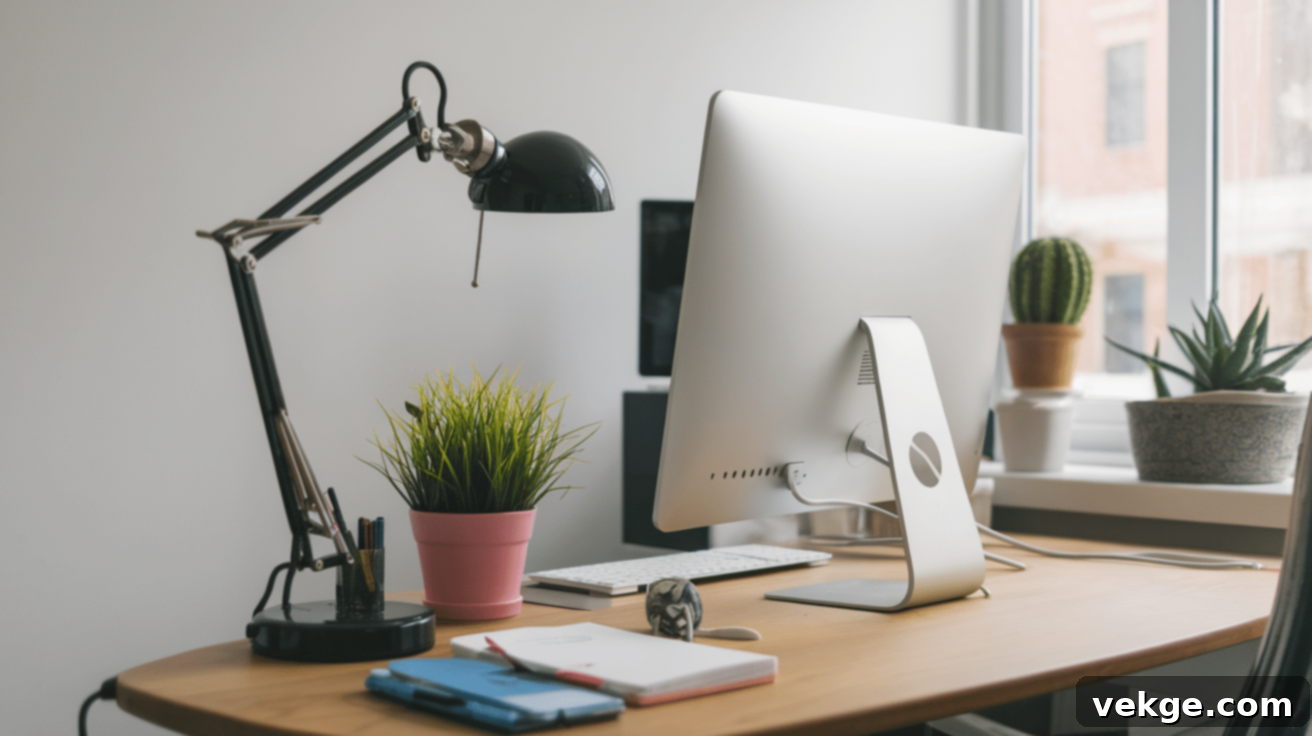
In a small office, visual clutter can quickly make a space feel cramped and distracting. Therefore, a minimalist approach to desk accessories is not just an aesthetic choice, but a functional necessity. Limit what you keep on your desk to only the items you use daily. Typically, this includes your computer, a simple task lamp, a small notepad, and a single pen holder. Every other item should have a designated storage place off the desk.
Avoid multiple containers for pens or stacks of papers that haven’t been filed. Before acquiring any new desk item, ask yourself if it’s truly essential for your daily workflow or merely “nice to have.” This careful, intentional approach to desktop organization not only saves money by preventing impulse buys but also creates a clean, calm workspace that significantly enhances your ability to focus and be productive. Remember, in small offices, an empty desk surface is a valuable asset, contributing to a sense of openness and order.
26. Use Textured Fabrics for Soft Accents
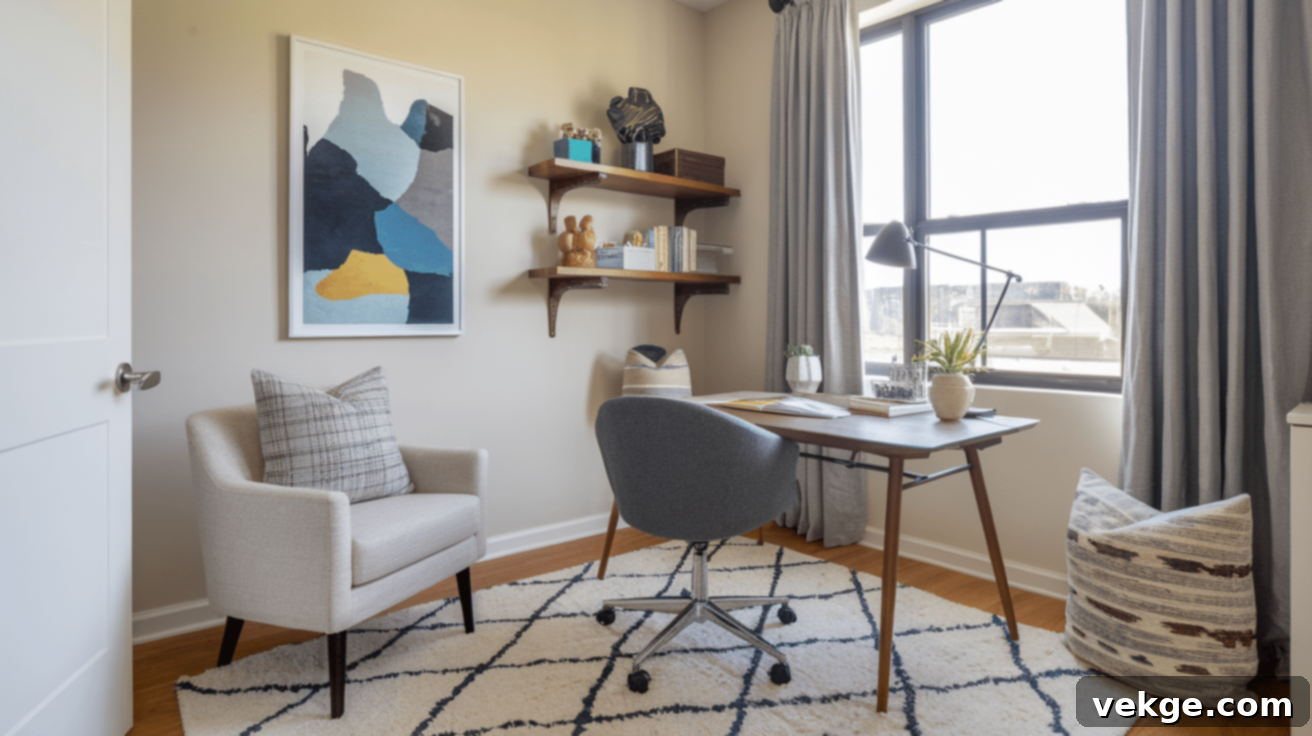
Adding warmth, comfort, and visual depth to a small office can be achieved with carefully chosen fabric items. These soft accents can transform a purely functional space into one that feels inviting and cozy. A small area rug placed under your desk not only defines your workspace but also adds a layer of texture and warmth. One or two decorative throw pillows on your office chair or a nearby accent seat can introduce color and comfort without occupying much room.
Look for these items at discount stores, home goods sales, or even secondhand shops to keep costs down. Incorporating different textures, such as soft knits, crisp cotton, or luxurious velvet, adds subtle depth and sophistication to the room, even in small doses. These tactile elements make your workspace feel more personal, welcoming, and less stark, which is crucial when you spend hours there. The right fabric accents can tie together your color scheme and make the entire space feel more finished and thoughtfully designed.
27. Install Hooks or Pegboards for Organization
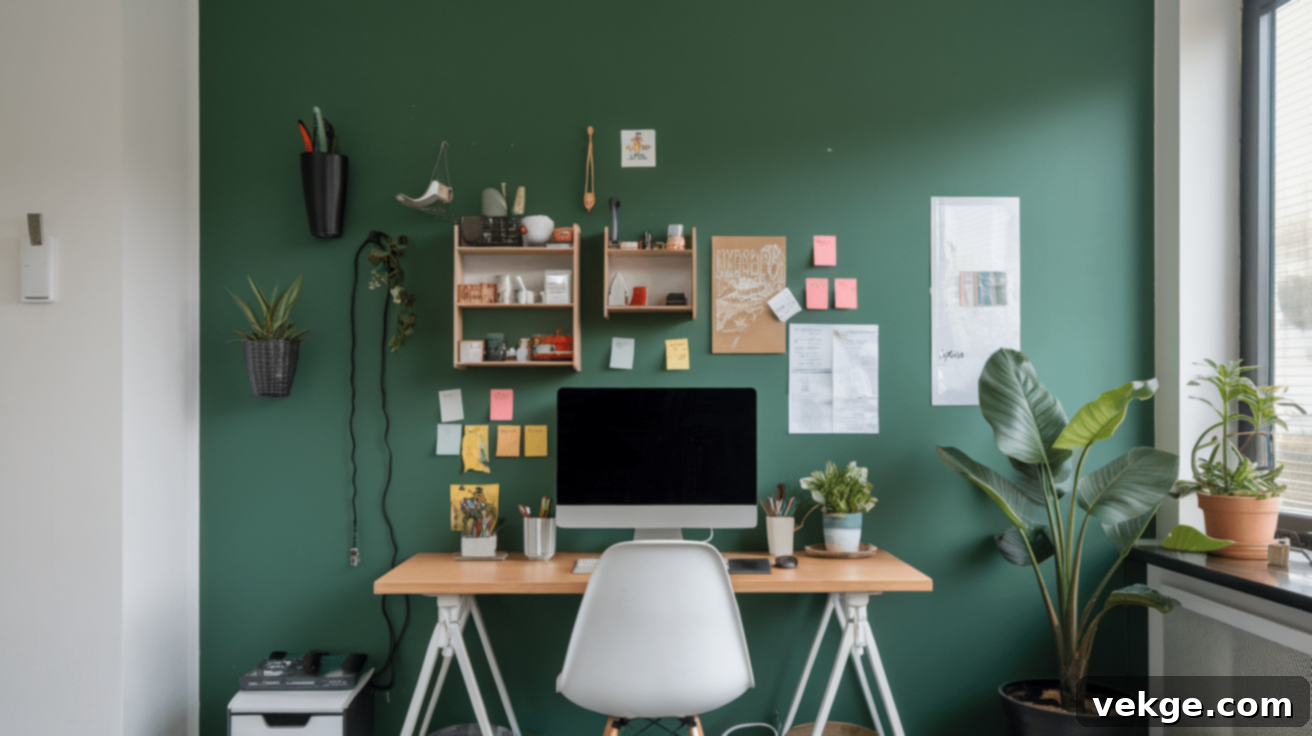
Wall-mounted organization systems are incredibly effective for keeping a small office tidy without consuming precious floor space. A pegboard is an incredibly versatile and budget-friendly option that offers flexible storage, easily adaptable as your needs evolve. You can hang small bins for office supplies, hooks for cables, headphones, or keys, and clips for important notes or inspirational images.
This system costs very little but makes a huge impact by getting items off your desk and keeping them visible and accessible. Simple, individual hooks installed near your desk or door provide convenient places to hang bags, coats, umbrellas, or even your daily planner. This ensures these items stay off chairs and floors, maintaining clear walkways and a professional appearance. For the most budget-conscious and renter-friendly approach, consider stick-on hooks that require no tools and won’t damage walls. Both pegboards and hooks cleverly utilize often-unused vertical wall space, helping maintain order and efficiency in limited square footage.
28. Use Colorful Storage Bins

Storage doesn’t have to be purely utilitarian; it can also be a design element. Bright, colorful storage containers are a fantastic way to inject life and personality into your small office while simultaneously keeping items neatly organized. Inexpensive plastic bins, fabric boxes, or metal containers in bold hues can sort papers, hold cables, store office supplies, or even act as recycling receptacles, all at a very low cost.
Look for affordable options at dollar stores, discount retailers, or craft stores where you can often find matching sets or complementary colors. Label each bin clearly with attractive labels so you know exactly what’s inside without having to open them. Stack smaller containers on shelves to maximize vertical space, and use larger ones for under-desk or floor storage. These practical items serve a double duty: they hide clutter effectively while adding vibrant pops of color to an otherwise neutral office space. The consistent use of colored bins throughout your office creates a cohesive and pulled-together look, even on the tightest budget.
29. Choose a Space-Saving Filing Cabinet
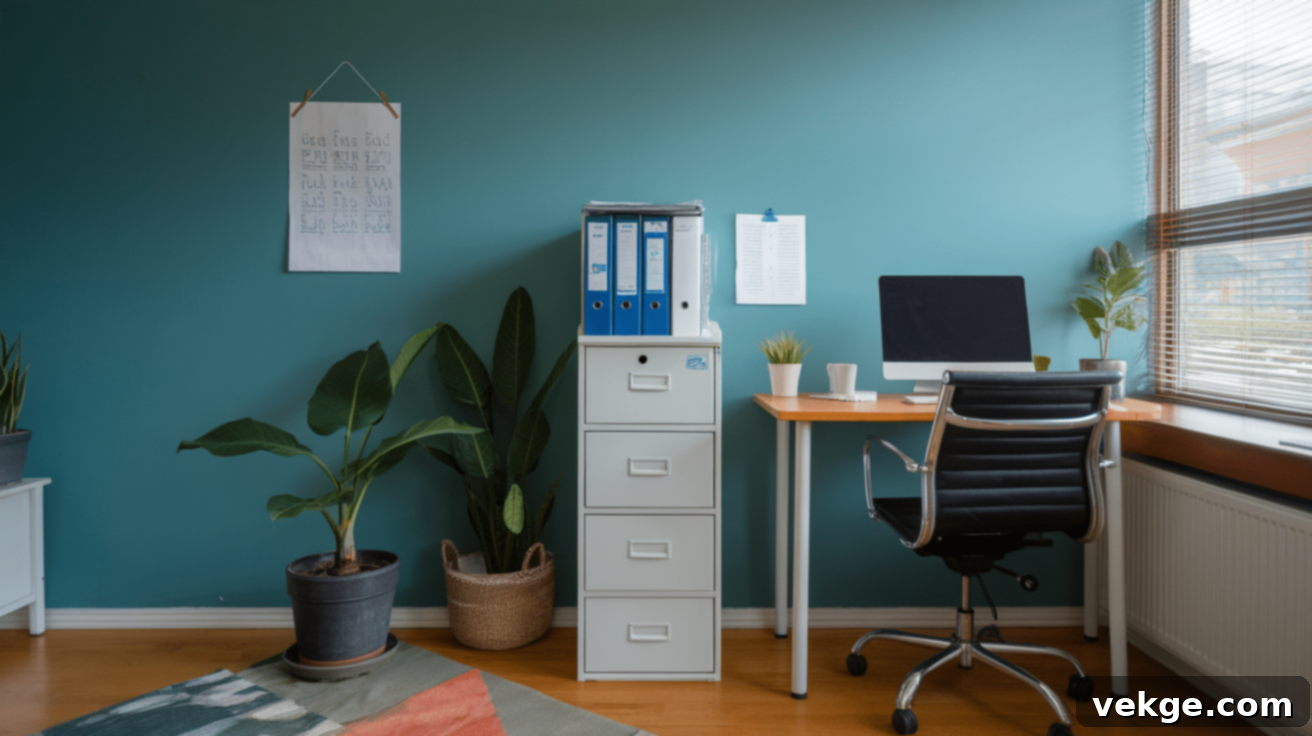
Physical document storage can quickly consume valuable space in a small office. To combat this, opt for filing cabinets designed for efficiency. Look for tall, narrow filing cabinets that emphasize vertical space rather than spreading horizontally across your limited floor area. These slim units can fit into tight corners, alongside desks, or in narrow alcoves where wider cabinets would be impractical.
Two-drawer or three-drawer models often provide sufficient storage for most small offices, maintaining a compact footprint. Many modern options come with wheels, allowing you to easily move them where needed and tuck them away when not in active use. Check office supply stores for sales, or consider secondhand options at office liquidation centers or online marketplaces for significantly better prices on quality units. Remember that embracing digital storage for documents can further reduce your need for physical filing space, allowing you to choose an even smaller cabinet than you might initially think, saving both space and money.
30. Create a Comfortable Break Area

Even in the smallest of offices, dedicating a tiny corner for short breaks during the workday can profoundly impact your productivity and mental well-being. A single comfortable chair – perhaps a small armchair, a cozy bean bag, or an upholstered dining chair – paired with a tiny side table is often all you need to create a useful rest spot. Look for secondhand furniture at thrift stores or online classifieds to keep costs low; you can often find quality pieces at a fraction of retail prices.
Enhance this area with a small plant, a few inspiring books, or a soft throw blanket to make it feel distinct from your main workspace. Taking short, intentional breaks in this dedicated spot helps refresh your mind far more effectively than simply scrolling on your phone at your desk. Even the smallest offices benefit from having a clear psychological boundary between work and rest. This simple, budget-friendly addition makes your office feel more complete, nurturing your energy and focus throughout the day.
31. Create a Personalized Workspace
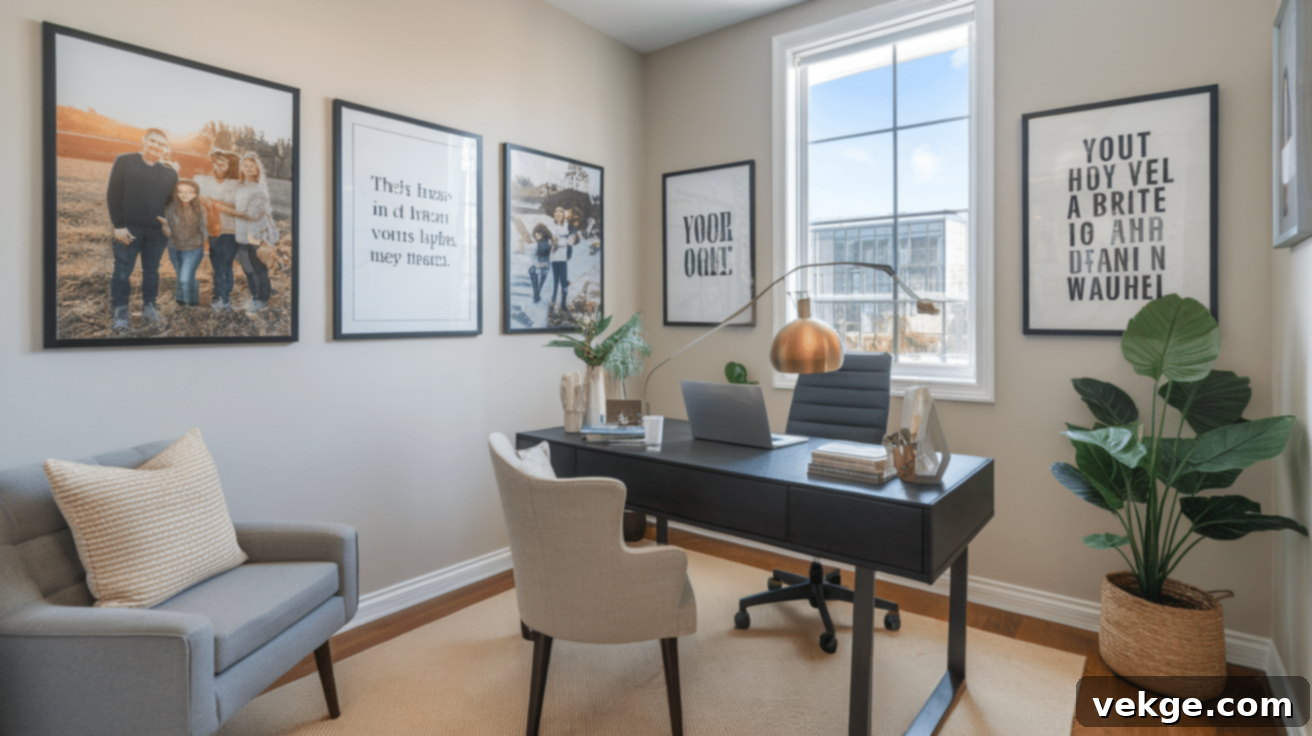
Ultimately, your office should be a place that feels uniquely yours, inspiring you to do your best work. Personalizing your small office with thoughtful, meaningful items is crucial for creating a comfortable and motivating environment. Add one or two framed family photos, pictures of loved ones, or a memorable travel snapshot to your desk or a prominent wall. Print and frame a favorite quote, mantra, or a business mission statement, placing it where you’ll see it often for a dose of motivation.
Small mementos, cherished souvenirs, or handcrafted items that hold personal significance can transform a basic work area into a space that feels deeply connected to your life, values, and aspirations. These personal touches cost very little but make an enormous difference in how you feel and perform while working. The key is to keep the number of items limited to avoid crowding your small space – prioritize quality and meaning over quantity. The goal is to craft a workspace that feels good to be in, reflects who you are, and inspires creativity, all without overspending or sacrificing valuable room with excessive decorations.
Conclusion
These comprehensive budget-friendly ideas clearly demonstrate that creating a highly practical, aesthetically pleasing, and inspiring small office is entirely achievable without spending a fortune. By embracing resourcefulness, planning intelligently, and thinking creatively about how you utilize your space, you can construct a workspace that not only meets all your functional needs but also looks fantastic and reflects your personal or brand identity.
The most successful small office designs are those that masterfully blend smart, space-saving storage solutions, multi-functional furniture, and thoughtful personal touches that make the room feel genuinely yours. Don’t feel pressured to implement every single tip; instead, select and combine a few ideas that best fit your specific space constraints, work style, and available budget. Remember, exceptional design isn’t about the amount of money you spend, but rather about how intelligently and intentionally you use the resources and space you have at hand to foster productivity and well-being.
